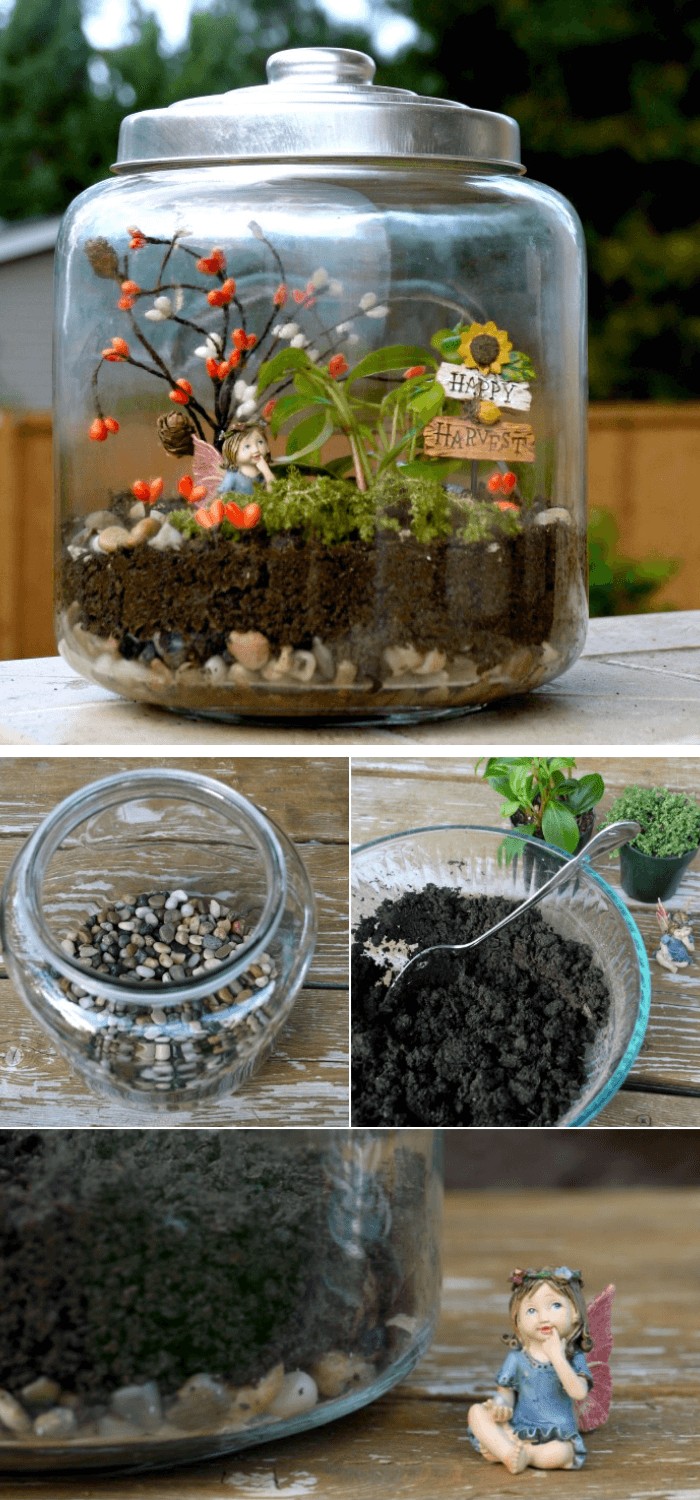34 Best Plants That Grow In Water (Without Hydroponics)
For those who struggle with soil gardening, growing plants in water can be a refreshing alternative. By doing so, you’ll avoid the mess of getting your hands dirty, tilling the soil, and dealing with pesky insects. Fortunately, there are numerous options for plants that thrive in water, without requiring a full-blown hydroponics setup. In this article, we’ll explore some of these possibilities, including helpful tips to ensure optimal growth.
Whether you already have a water-based plant or are just starting out, you’ll find valuable insights on how to cultivate your aquatic plants robustly. Some examples of houseplants that grow well in water include Begonia, Chinese Evergreen, Coleus, English Ivy, Geranium, Lucky Bamboo, Peace Lily, Philodendron, Pothos, Spider plant, and Wandering Jew. Herbs that also flourish in water include Basil, Chives, Lavender, Lemon Balm, Mint, Oregano, Rosemary, Sage, Stevia, and Thyme.
Vegetables can also be regrown in water, such as Beet greens, Bok Choy, Carrot Tops, Lettuce, Leeks, and Green Onions. For edible plants that grow in ponds, consider Taro, Sweet Potato Vine, Water Spinach, or Lotus. Finally, tropical plants like Giant Horsetail, Egyptian Paper Reed, or Umbrella Grass can thrive in water as well.
11 House plants that grow in water
While some plants can thrive with roots submerged in water, others would perish. The difference lies not just in propagation, but in the ability of certain species to grow entirely in this medium. Hardy and versatile indoor plants are best suited for this unique environment. To facilitate growth in water, gardeners often incorporate amendments like water beads or expanded clay pebbles.
For those looking to experiment with hydroponic houseplant cultivation, here’s a selection of hardy species that can be grown in water.
Begonia

The begonia is an eye-catching flowering plant that thrives as an ornamental, boasting showy blooms that can be displayed in vases or containers. Its vibrant pink, old rose, and bright red hues make it a popular choice for cut flower arrangements. To grow begonias in water, you’ll need to take 6-inch stem cuttings with at least three leaves intact. Place the cutting in a glass jar, ensuring the nodes are submerged in water but the leaves remain above the surface.
Adding liquid rooting hormones can aid root development, which may take two to three weeks. Remember to change the water in the jar once a week to maintain optimal growing conditions.
Chinese Evergreen
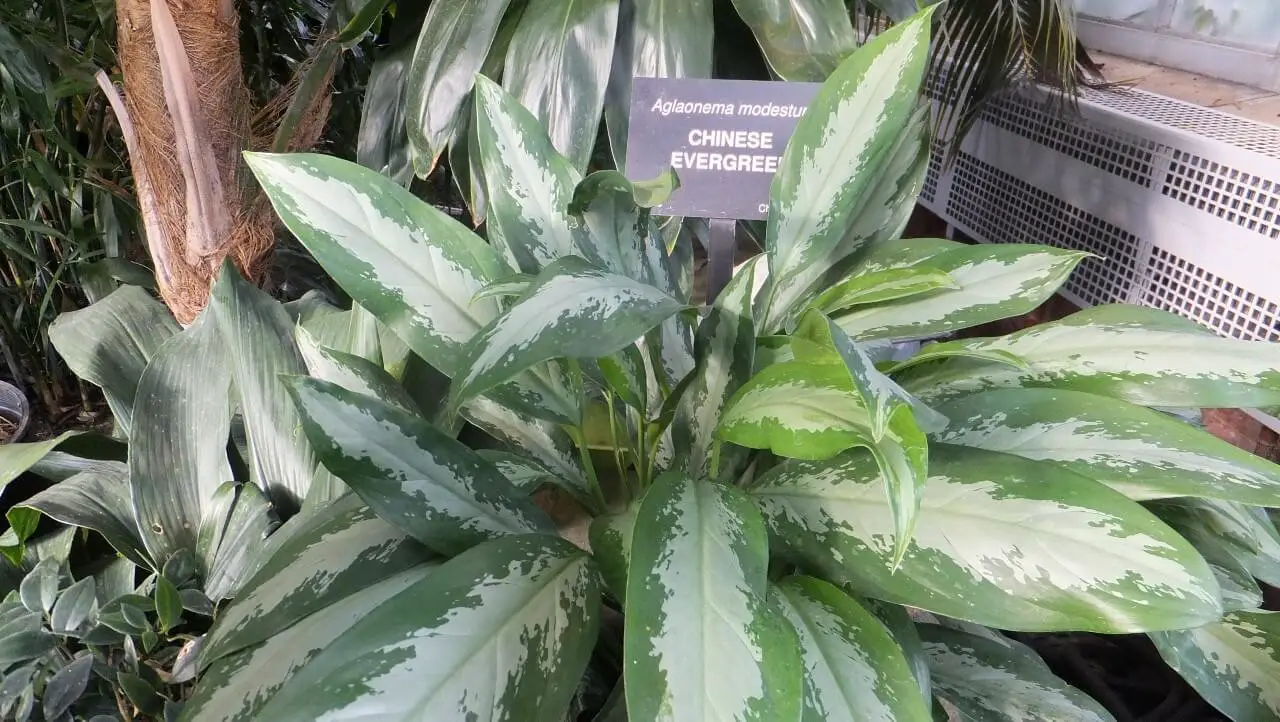
To propagate this aquatic plant using the stem method, start by selecting a healthy mother plant and cutting about 6 inches from its stem, just below the leaf node. Place the cut end in a vase filled with enough water to submerge the roots. While rainwater is ideal for these plants, tap water can be used as a substitute. However, if you’re using tap water, make sure to leave it out for at least 24 hours to allow any chlorine to evaporate, which can inhibit plant growth.
This particular species is relatively hardy, but if you encounter difficulties during the propagation process, adding gel or water beads may help to alleviate these issues.
Coleus

One of the most distinctive varieties is characterized by its large, broad, and vibrantly colored leaves that depart from those of the aglaonema. While sharing the same dotted pink or yellow markings within the leaf’s texture, this type thrives in water alone, provided it receives a steady supply of liquid fertilizer. Notably, when propagating via stem cuttings, this variety will produce buds rather than nodes.
To initiate the process, select a cutting that measures at least six inches and remove all but the topmost leaves from its lower portion. Submerge only the bud-bearing section in water, taking care to keep the leaves above the surface. Regularly change the water and supplement it with liquid fertilizer as needed. The reward for this effort is a stunning plant capable of producing a kaleidoscope of red, green, and pink hues.
English Ivy
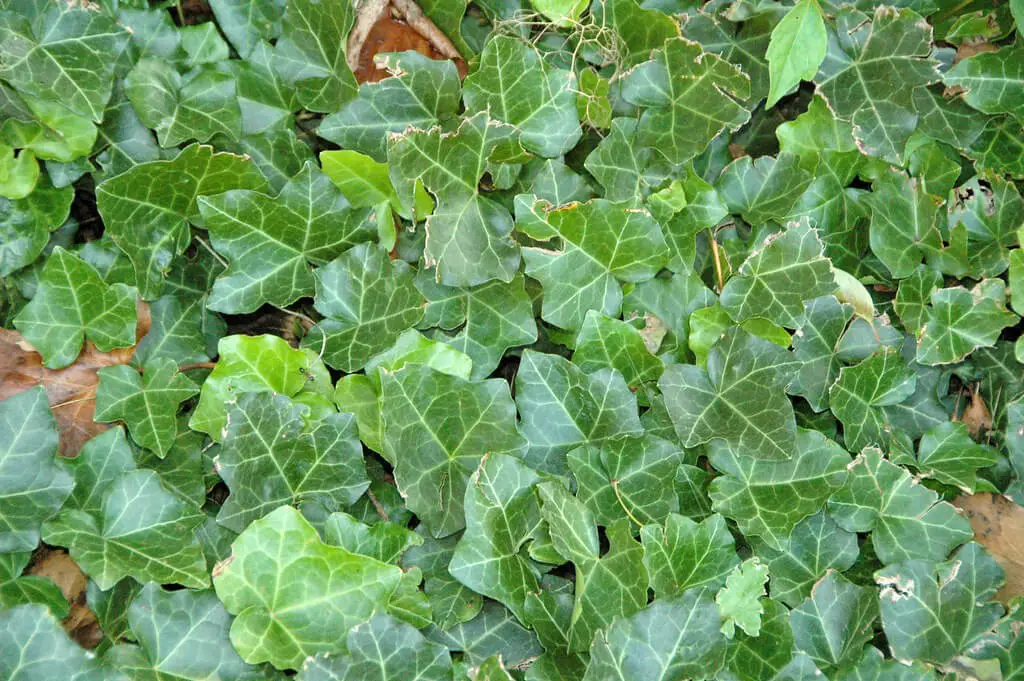
Contrary to popular belief, it’s possible to grow English ivies in water, not just for propagating purposes. This means you can transfer the plant to water and leave it there indefinitely, allowing it to thrive just as it would in pots or soil. When transferring, be sure to cut off stems with at least one emerging leaf, ideally 4-6 inches long. Place these stems in a glass vase filled with water, ensuring only the stems are submerged and not the leaves.
Periodically change the water when necessary, such as when it becomes stale or takes on a yellow or brown hue. The English ivy is also known for its hardiness, preferring moist environments and excelling as a ground cover or creeper.
Geranium
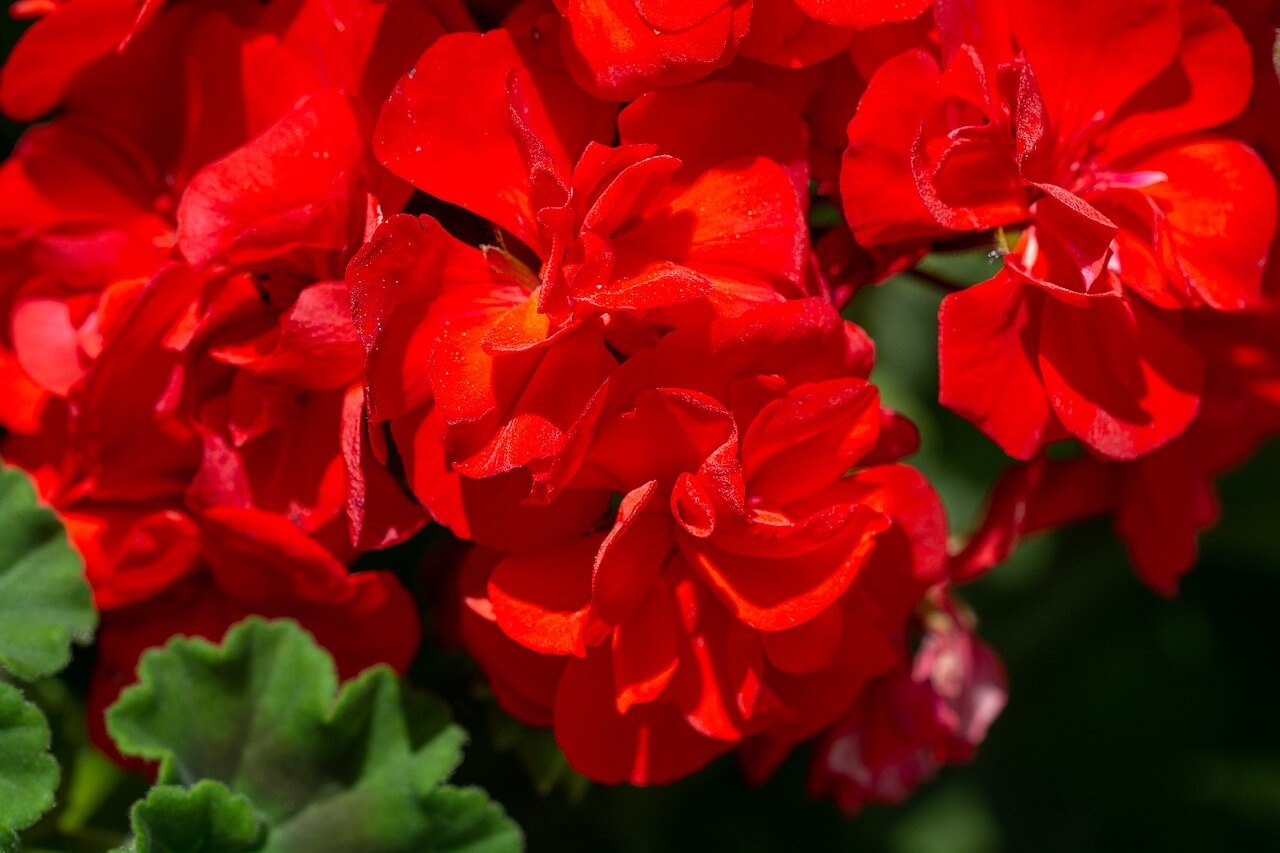
The Prayer Plant’s popularity stems from its impressive traits: it grows rapidly, thrives in challenging conditions, and requires minimal care. Its vibrant, fragrant leaves create a stunning display that instantly brightens up any room. As an added bonus, it produces showy, large pink flowers that make a bold statement indoors. To cultivate this plant in water, start by selecting a healthy 4-6-inch stem cutting with a node above the last leaf set.
Remove all the lower leaves, leaving only those attached to the top of the stem. Submerge the cut end in enough water to cover it, taking care not to fully submerge the leaves. Place the cutting where it will receive sufficient indirect sunlight, and be patient as it takes about a month for roots to develop. One of the Prayer Plant’s most appealing features is its ability to survive indoor overwintering conditions.
Lucky Bamboo
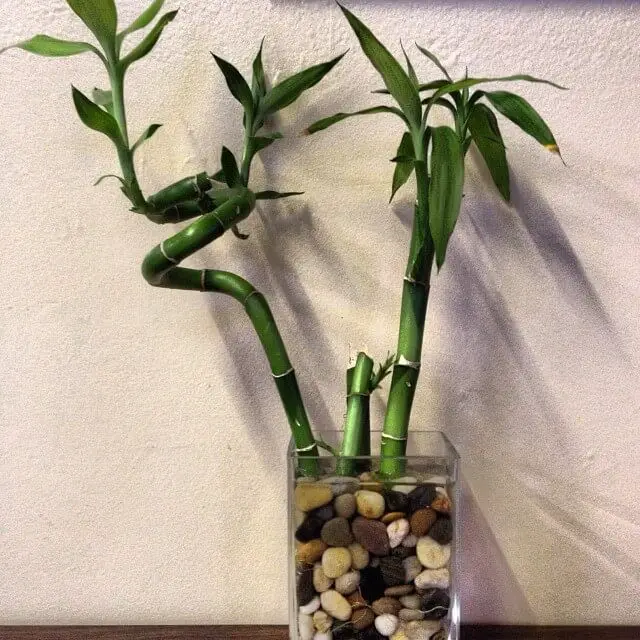
For those who subscribe to the principles of feng shui, lucky bamboo is an ideal choice for growing plants in water. According to traditional beliefs, this plant is said to symbolize wealth, happiness, and prosperity, making it a popular option for those seeking to bring these energies into their lives. In terms of placement, specific locations and directions are believed to be crucial in maintaining the positive effects of lucky bamboo.
For instance, its orientation can greatly impact the flow of energy, or chi, around us. When it comes to cultivation, the more stalks grown, the greater the perceived wealth is likely to be. What’s more, growing this plant in water requires minimal equipment – a shallow dish will suffice, as long as the roots are submerged. Adding pebbles can also help secure the roots and promote healthy growth. However, when it comes to the water itself, lucky bamboo is quite particular.
Only distilled or purified water will do, and regular changes (every week) are necessary to keep the plant thriving. Additionally, occasional use of liquid fertilizer can provide an extra boost, ensuring that your lucky bamboo remains healthy and vibrant.
Peace Lily
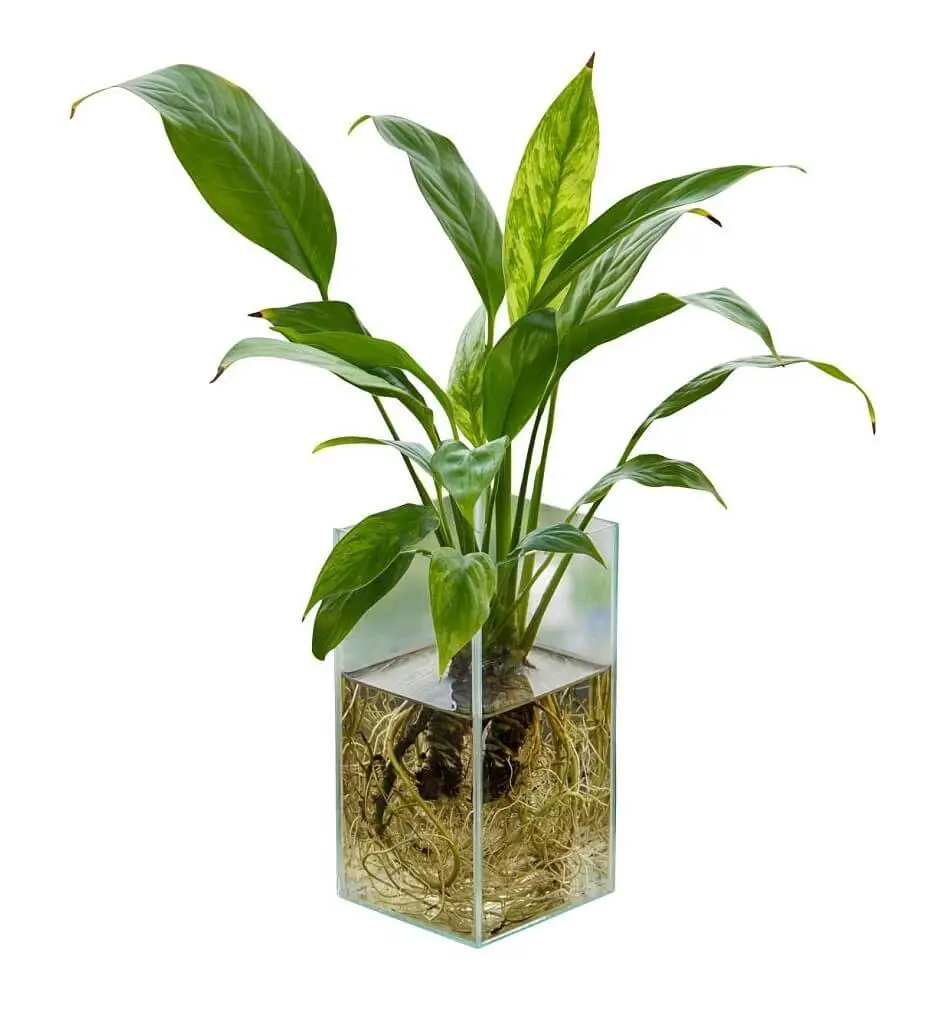
When cultivated in water, peace lilies exhibit a stately appearance. To replicate this setup, start by carefully removing a mature peace lily from its pot and placing it into a basin filled with lukewarm water. Gently shake off any dirt until the roots are visible, then trim away any offshoots and crown. Leave at least four leaves intact on the cut stem and submerge it in a jar filled with water, ensuring that the roots remain saturated.
To maintain optimal conditions, change the water in the vase every week. In terms of lighting, peace lilies will thrive under bright, indirect light. Additionally, providing a few drops of liquid fertilizer can be beneficial upon transferring the plant to its new aquatic environment. This should be done approximately every six weeks. Peace lilies are essentially water plants, so there’s no need to worry about their ability to flourish in this unique setting.
In fact, when grown directly in water, they’ll follow a similar cycle to that of potted peace lilies.
Philodendron
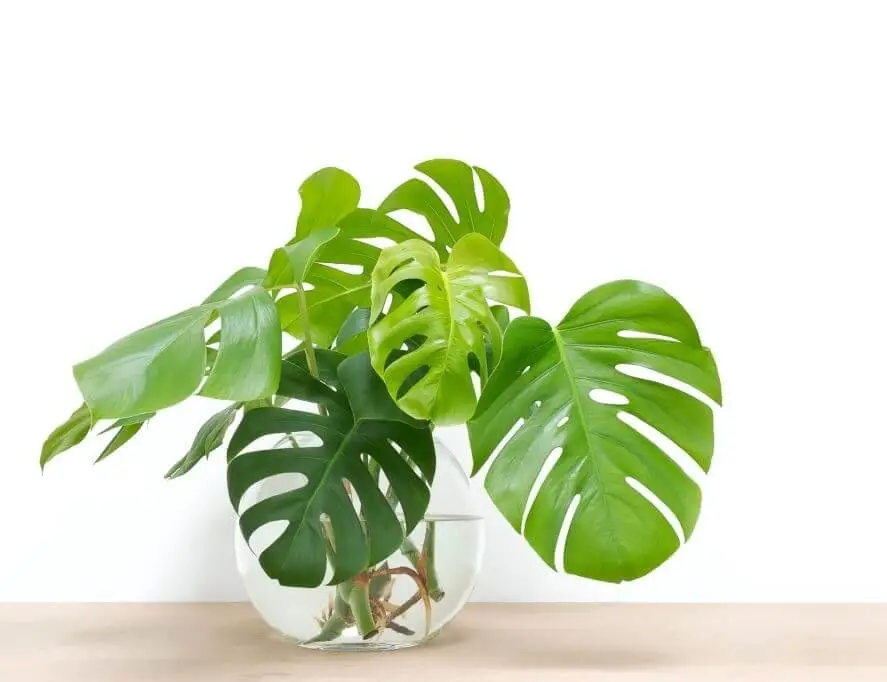
This remarkable plant exhibits exceptional resilience when cultivated in water, showcasing little to no issues despite its adaptability to low-light environments and varying water conditions. Its reputation precedes it – if left submerged in water for an entire year without maintenance, the plant remains green and healthy, a testament to its tenacity.
One notable aspect of this plant is its ability to absorb even the faintest light, attributed to its dark, broad leaves that can harness illumination from as little as a room’s ambient glow. To initiate propagation, begin by selecting a 6-inch stem from the mother plant, just 0.25 inches below the leaf node, and spare 2-3 intact leaves.
When submerging the cut section in water, ensure that all nodes are fully submerged to facilitate root growth while minimizing stress.
This hardy plant thrives in good room temperature conditions, making it an excellent choice for those seeking a low-maintenance yet rewarding aquatic experience.
Pothos
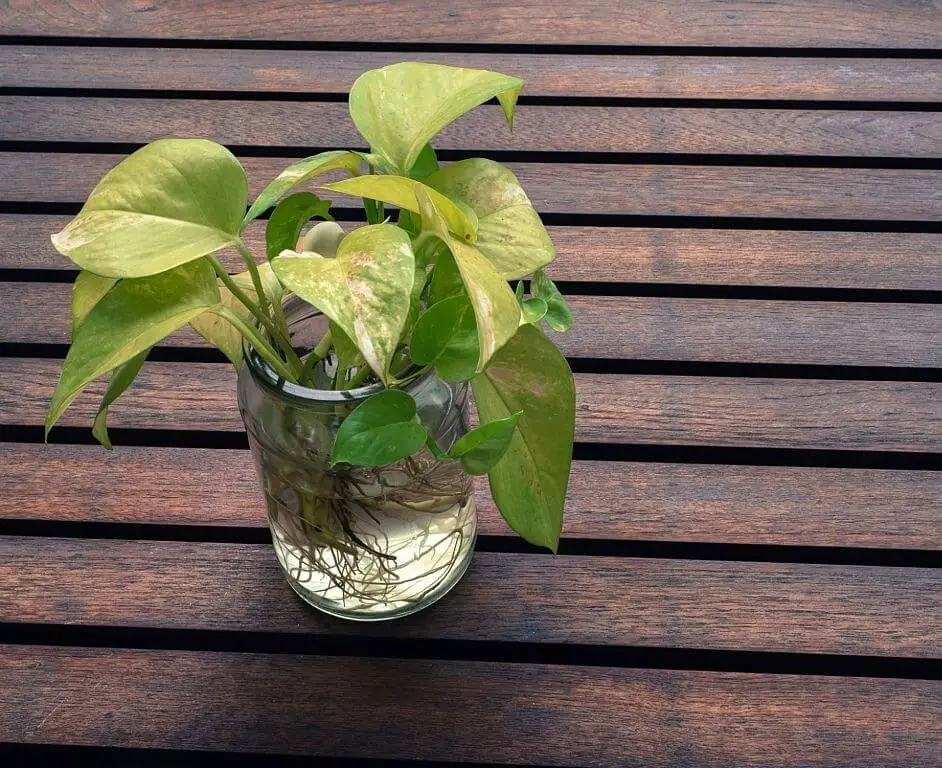
Pothos, also known as devil’s ivy, has earned its name due to its potential to become invasive in the wild. However, when grown in water and vases, it can bring a touch of freshness to indoor spaces. Moreover, pothos is renowned for being one of the eight most potent air-purifying houseplants, making it a popular choice for offices and high-traffic areas like living rooms. It’s also not uncommon to find this plant adorning bathrooms and bedrooms.
Nevertheless, it’s essential to note that pothos requires a tinted glass vase or dark-colored jar to prevent algae buildup. To ensure the plant receives the necessary phosphorus and nitrogen, a light application of liquid fertilizer is recommended. Additionally, regular watering is crucial, with the water changed once every week.
Spider plant
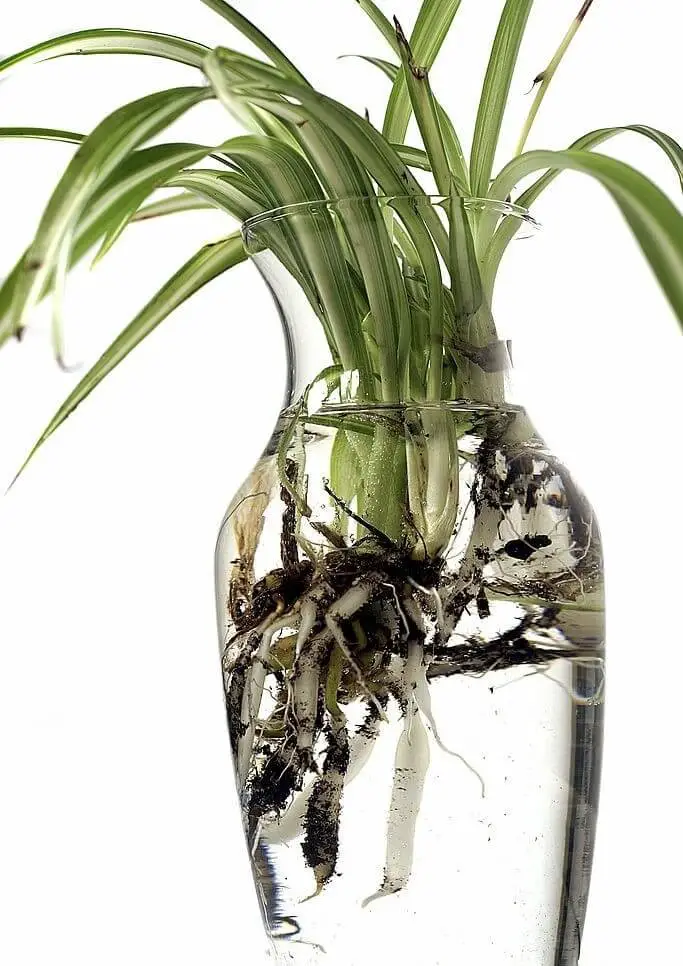
While they’re not typically classified as aquatic plants, these species can thrive in water environments. To initiate growth, you’ll need to obtain plantlets rather than stem cuttings. Submerge the plantlets in water for three to six weeks, allowing the roots to develop before transitioning to a medium with expanding clay pebbles. One of the primary challenges when growing this type of plant is managing salt buildup.
As leaves begin to yellow, it may indicate that the water has become too saline. To mitigate this issue, regular water changes (at least once a week) are crucial. Additionally, consider applying liquid fertilizer on a monthly basis to provide essential nutrients.
Wandering Jew
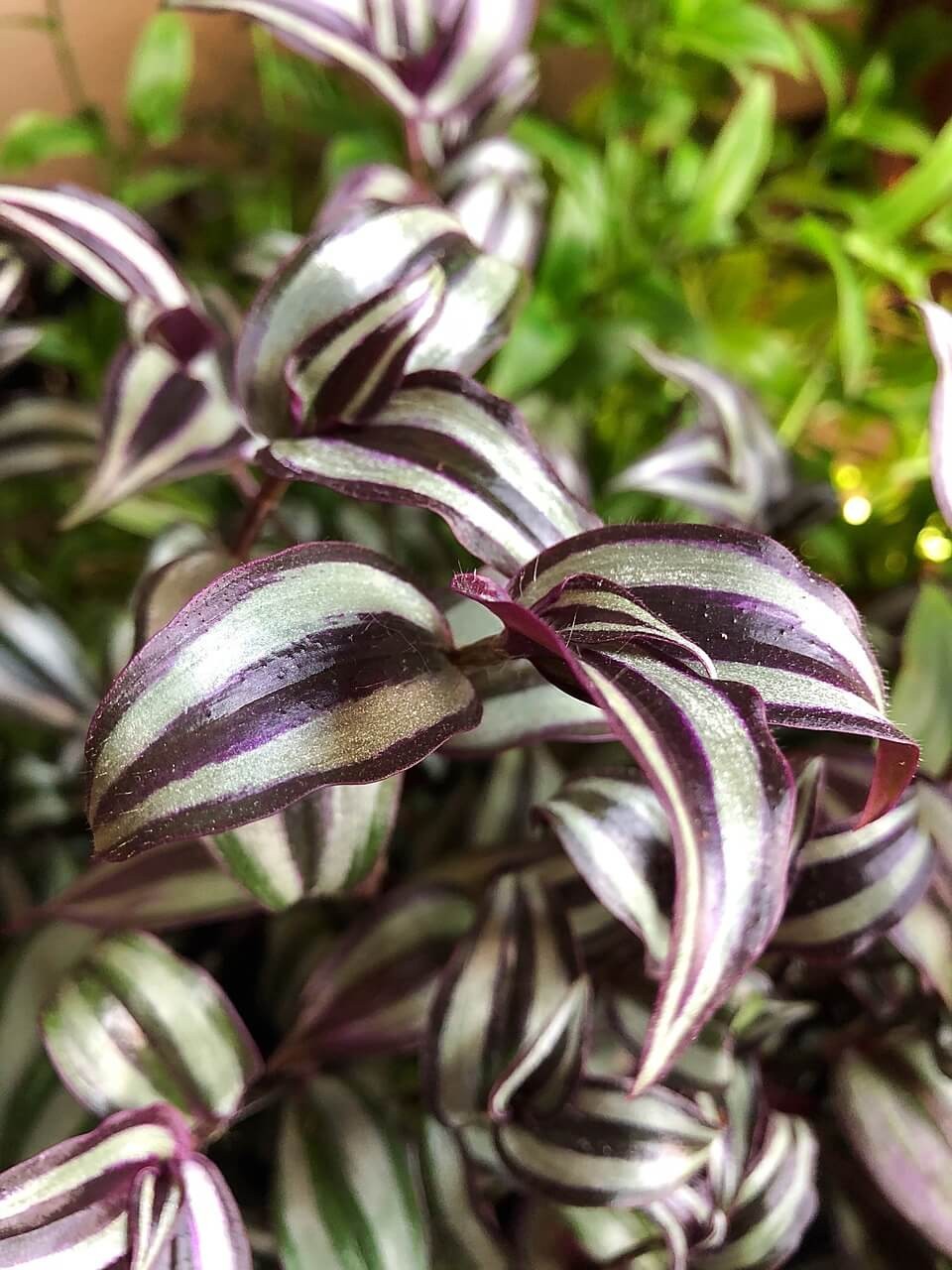
For those seeking a vibrant indoor plant that thrives in water, this option is an excellent choice. Its unique foliage features a stunning combination of green, purple, and silver hues. As it grows, it can create a stunning trailing display by the bookshelf or coffee table, adding a pop of color to your space. To propagate this plant, simply cut two to three stems from the mother plant, leaving two leaves intact. Larger vases can accommodate six to eight stems.
When submerging the stems in water for the first time, it’s essential to separate them into individual cups and allow them to sit for 48 hours before combining them in a single vase. This fast-growing plant is surprisingly rapid in its development, with new leaves and roots emerging as soon as 24 hours after initial propagation.
9 Herbs that grow in water
The joys of having fresh herbs at your fingertips! As a home cook, being able to effortlessly clip fragrant leaves right from your kitchen or outdoor vases can be incredibly satisfying. But did you know that growing herbs in water is not only a convenient way to propagate them, but also a clever method for multiplying your favorite flavors? It’s like having the ultimate herb garden at your disposal!
For instance, many popular herbs such as basil, mint, and rosemary thrive when planted in water, allowing you to enjoy their unique properties with minimal fuss.
Basil
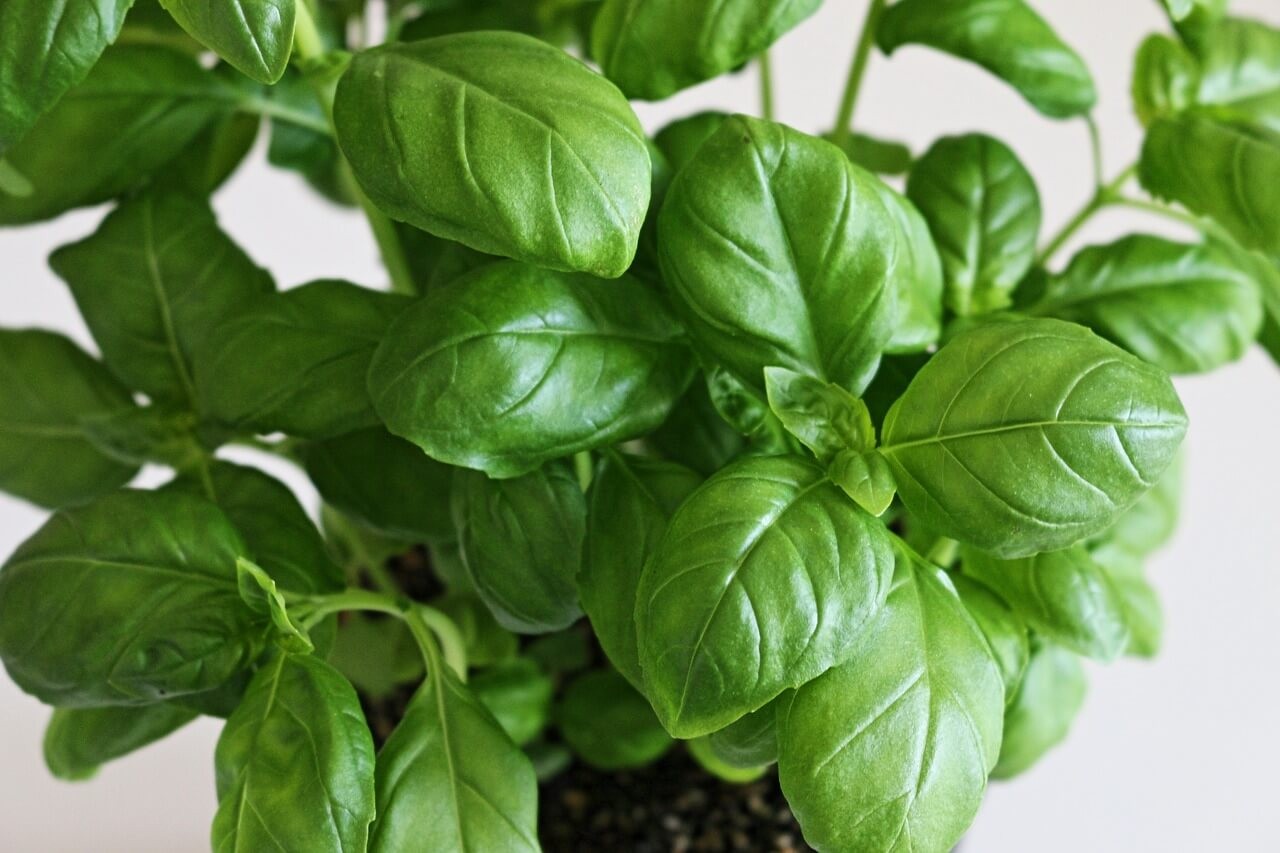
Basil, a staple herb in Italian cuisine, is renowned for its pungent aroma and versatility. As the key ingredient in pesto, it’s no surprise that many of us crave a reliable source of fresh basil at home. This fragrant herb plays a vital role in various dishes, including pasta sauces, soups, and even refreshing drinks. Once the mother plant has developed at least 2 inches of roots, it can be used as a cutting to regrow in water, providing a continuous supply of leaves.
Basil is a rapid grower, requiring only a shallow dish to thrive. Within just a week, you’ll witness significant growth, and soon enough, you’ll have a steady stream of fresh basil leaves at your disposal.
Chives
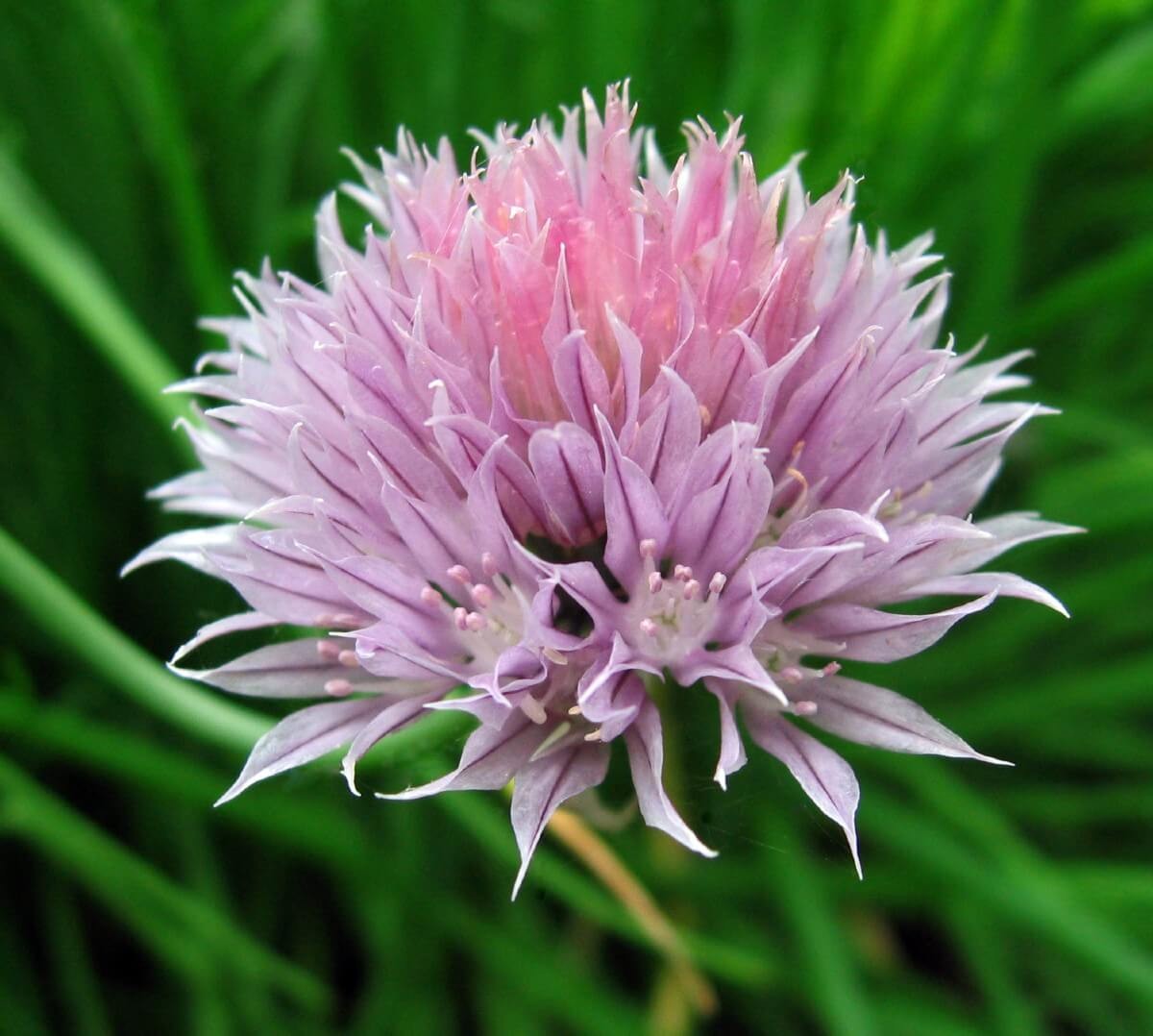
While garlic and chives are often confused with one another, they are distinct herbs with unique flavors and uses. Chives have a milder taste than garlic, falling somewhere between the pungency of onion and the savory flavor of garlic. Their versatility has made them a staple in many dishes, from egg sandwiches to salads, soups, and sauces. When it comes to growing chives, the process is surprisingly simple.
Start by planting a garlic clove in a shot glass filled with water, leaving about a quarter-inch of the clove above the surface. Place the shot glass on a sunny windowsill, where the clove can bask in plenty of sunlight. Within a few days – typically around 3-4 days – you should start to see chives sprouting from the clove.
Lavender
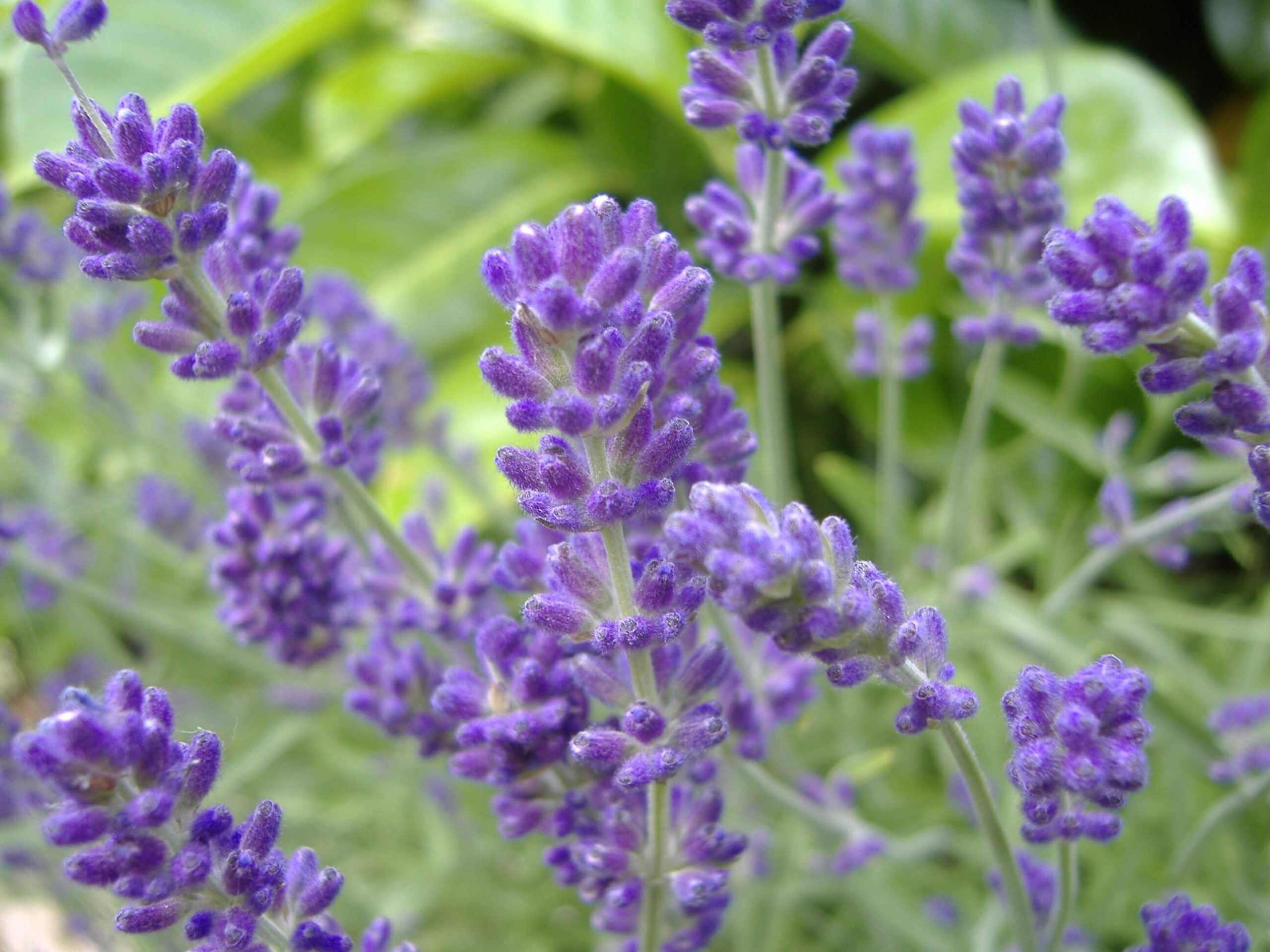
Lavender is another highly therapeutic herb, cherished for its calming properties and soothing aroma. Its versatility has made it a staple in various products, including essential oils, candles, and teas. Notably, lavender’s medicinal benefits extend to alleviating cramping, migraines, and stress-induced insomnia, while also boosting one’s mood. To cultivate this fragrant herb, begin by obtaining fresh stem cuttings (2-3 inches long) and submerge them in an opaque container filled with water.
Place the jar on a sunny windowsill, allowing the lavender to thrive for approximately two weeks before harvesting. As it grows, you can expect a steady supply of this calming herb.
Lemon Balm
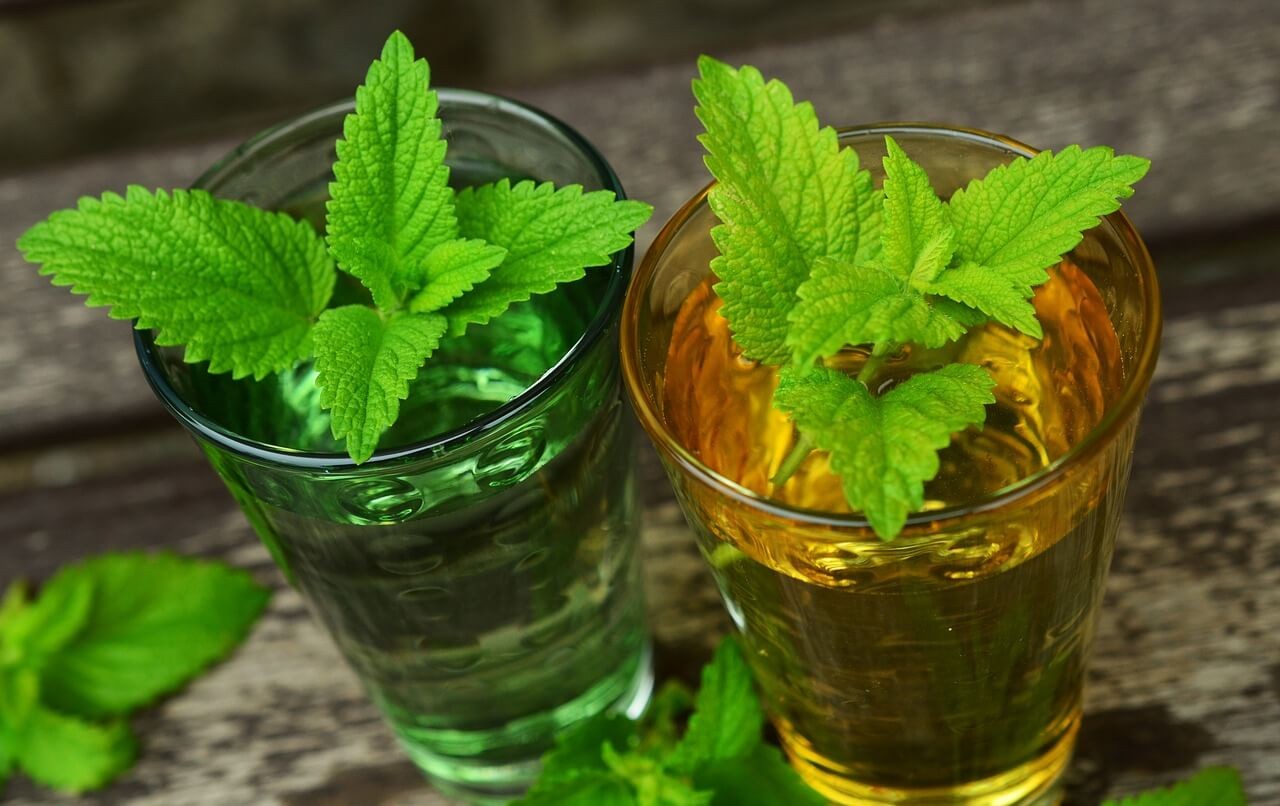
Lemon balm, renowned for its therapeutic properties, not only enhances culinary delights but also soothes the mind in calming teas. Scientific evidence supports its sleep-inducing, stress-reducing, and digestive-issue-preventing benefits. For successful propagation through water cultivation, take 3-inch stem cuttings from a healthy mother plant, leaving at least two to three top leaves intact.
This fast-growing herb is prone to mildew, making it essential to change the water daily to promote optimal growth and prevent fungal issues.
Mint
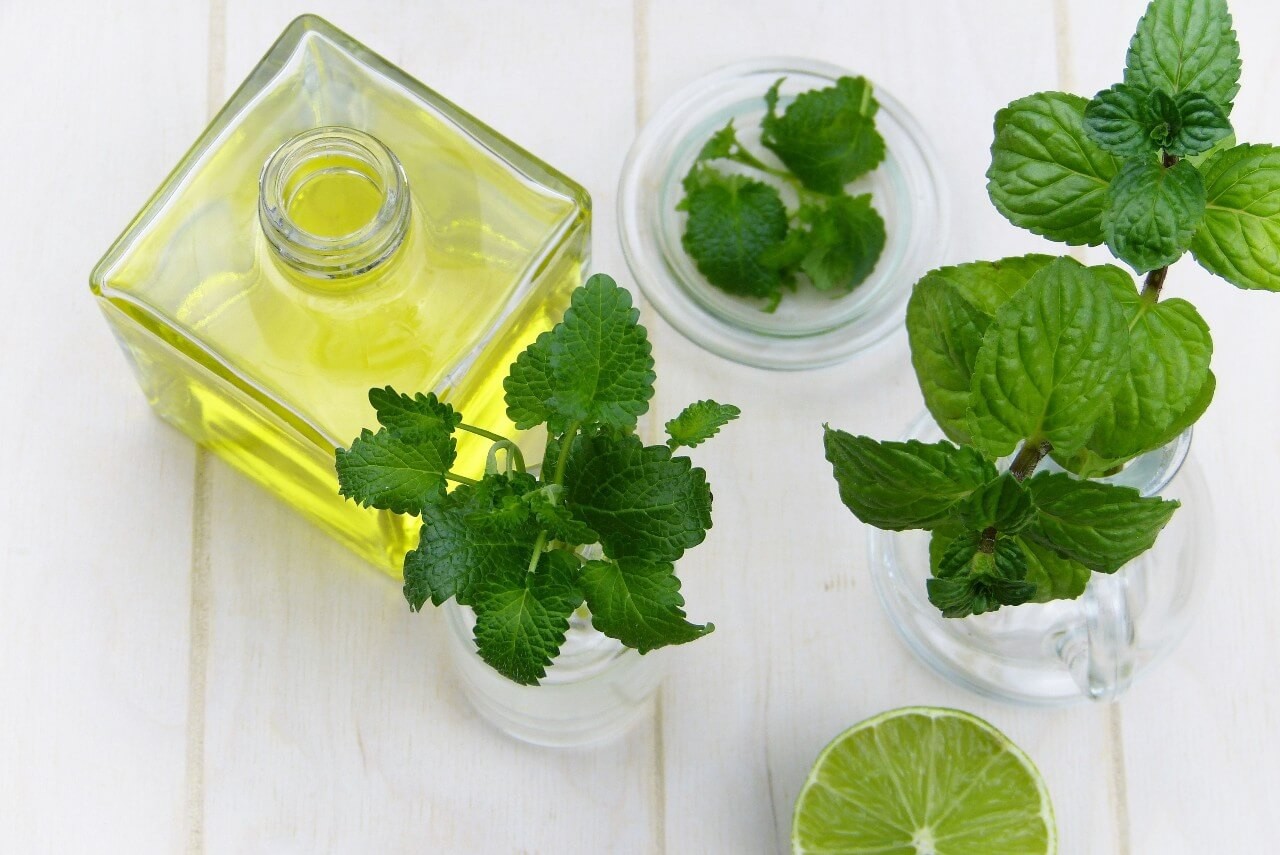
Having a steady indoor supply of this herb can elevate any pasta dish or beverage. Its medical properties make it particularly valuable for treating various digestive issues. It effectively soothes stomach aches, aids indigestion, and combats infection thanks to its antibacterial properties. Additionally, it serves as a natural mosquito and insect repellent.
Propagating this herb through water is remarkably straightforward.
Simply take stem cuttings of 2-3 inches in length, cutting just below the leaf node on thicker stems. Place them in a glass with ample but indirect sunlight. If you reside in an area with intense heat, consider using a terrarium setup with ¾ water. Due to its rapid growth rate, you can expect visible progress daily. Be sure to change the water every three days to ensure optimal propagation.
Oregano
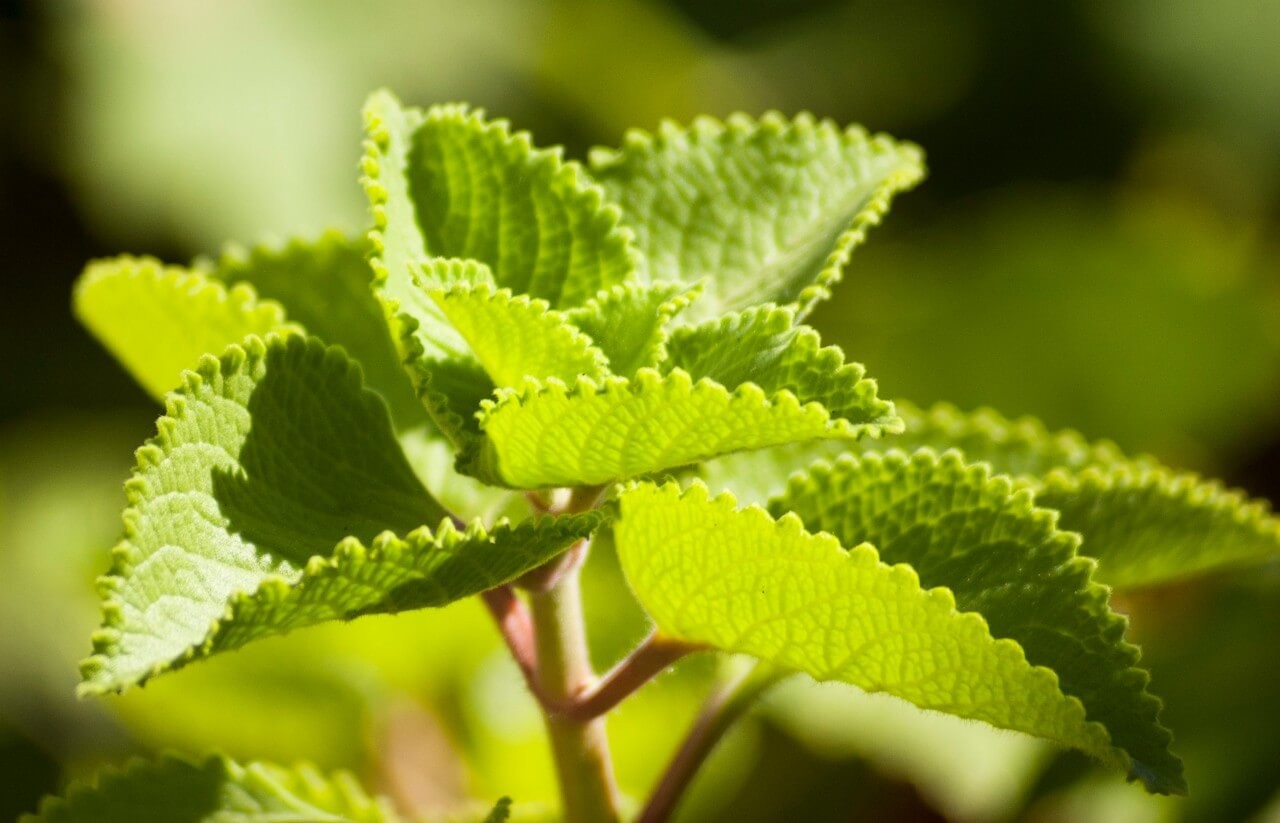
Oregano, a member of the mint family, is one of the most widely utilized herbs for cooking and boasts impressive medicinal properties. Its antibacterial capabilities make it an effective tool in combating infection, while its rich antioxidant content has been linked to anti-aging compounds and cell regeneration effects. Additionally, oregano is a reliable source of calcium and potassium.
To cultivate this plant hydroponically, start by obtaining a stem cut from a healthy oregano mother plant, ensuring the stem measures 4-6 inches in length. Remove all leaves from the lower half of the stem before submerging the lower part into water. Change the water every three to four days until roots begin to appear within a week or two. Note that oregano prefers tap or spring water over distilled water for optimal growth.
Rosemary

Rosemary, a versatile and aromatic herb, boasts impressive culinary and medicinal benefits. Beyond its ability to elevate savory dishes and soups with its distinct flavor, rosemary also offers relief from indigestion and promotes healthy blood circulation. Its edible flowers, when fresh, are prized for their more intense flavor profile compared to dried herbs. A staple in many cuisines, rosemary is often used in poultry, lamb, oily fish, pork, and steak dishes.
In addition to its culinary applications, rosemary can also be easily cultivated indoors through hydroponic methods. This perennial shrub produces beautiful blue flowers during the spring season when provided with suitable conditions. To initiate this process, simply cut a 3-inch stem from an existing rosemary plant and place it in a spot receiving ample sunlight, such as a windowsill.
For optimal growth, be sure to change the water once a week to prevent algae buildup, and consider using darker-tinted vases to promote healthy development.
Sage
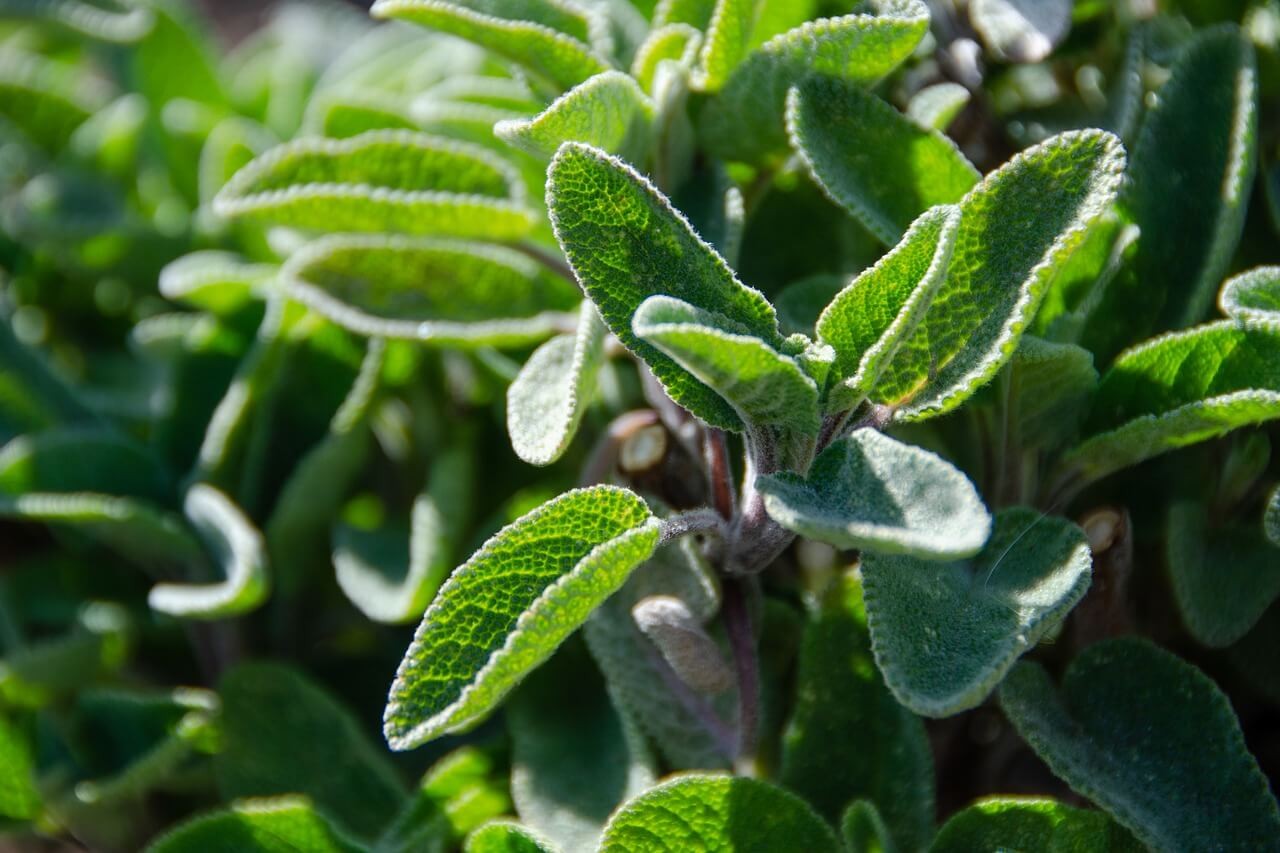
The unmistakable aroma of sage evokes memories of Thanksgiving feasts, where it harmonizes beautifully with thyme in poultry dishes like chicken and turkey. But sage’s virtues extend far beyond the culinary realm. Its impressive medicinal properties make it a go-to remedy for stomach upset, indigestion, loss of appetite, flatulence, diarrhea, and heartburn.
When cultivating sage indoors, potting or regrowing it in water are excellent options.
To get started, you’ll need a 2-3 inch stem cutting, which should be dipped into a shallow dish before planting. As the herb requires sunlight to thrive, place it on your windowsill and wait for the magic to unfold.
One of sage’s most appealing characteristics is its ability to regenerate itself with remarkable resilience. No matter what you do, this hardy herb will continue to grow back, providing a steady supply of fresh leaves.
Stevia
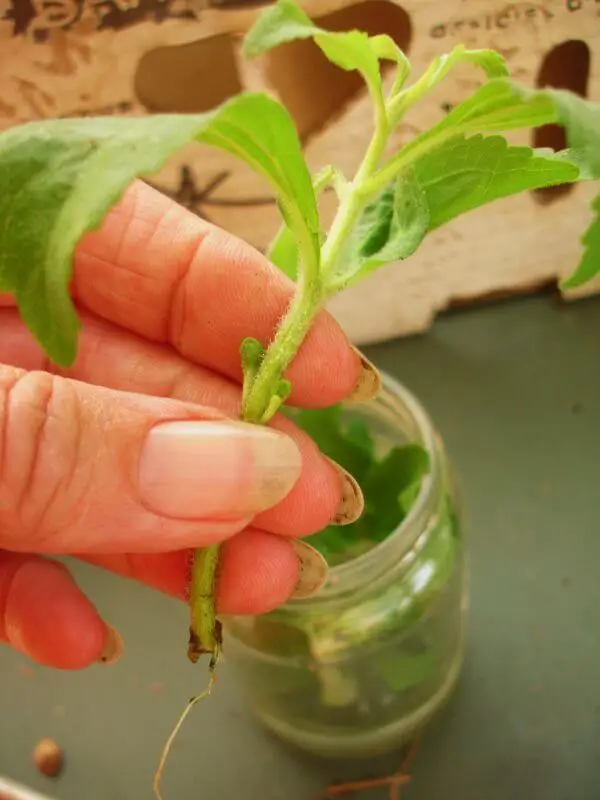
Recent buzz surrounding this plant is due to its potential as a low-sugar, low-calorie substitute for sugar. Its unique properties make it an attractive alternative. To cultivate it indoors, start by obtaining stem cuttings from a mature plant. Submerge 2-3 inches of the cutting, complete with at least two leaves, in a shallow dish of water. Place the cutting in a clear glass jar and position it near a sunny windowsill for optimal light exposure.
It’s essential to monitor this plant closely, as it has a tendency to thrive even when grown in water. Once healthy leaves develop, you can harvest one or two at a time, boiling them to create sweet tea or using them as a natural sweetener in your coffee.
Thyme
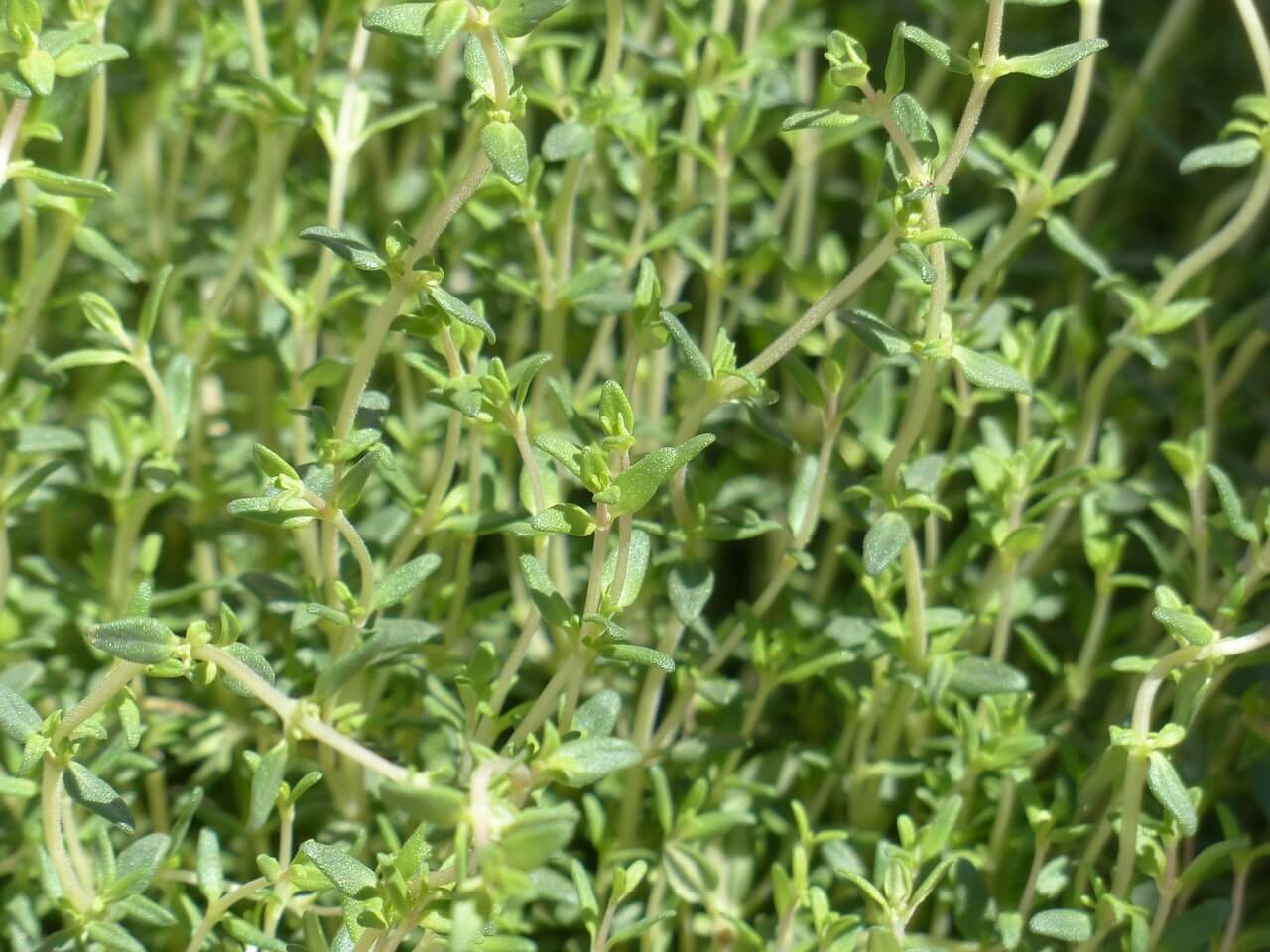
Thyme is often referred to as the sage’s trusted companion when it comes to cooking poultry dishes, and its versatility extends beyond the kitchen. Like basil, thyme hails from the Mediterranean region and boasts a range of medicinal properties. It has been known to provide relief for various ailments, including indigestion, sore throats, arthritis, stomachaches, and diarrhea.
When cultivating thyme in water, start by obtaining a healthy stem cutting approximately 3 inches long, complete with its top leaves intact. Submerge the cut end in enough water, ensuring that the leaves remain above the surface. Place the vase in an area receiving indirect sunlight, allowing the thyme to develop roots over the course of two weeks. To maintain the health and purity of the water, change it every three days.
An opaque glass container is recommended to prevent algae buildup and keep your thyme thriving.
Vegetables You Can Regrow in Water
While it’s not possible to grow certain vegetables directly in water without a sophisticated hydroponics system, there is a valuable takeaway from the process of peeling and preparing these veggies. What we’re left with are nutrient-rich scraps that would otherwise be discarded. However, with some creativity and a little experimentation, you can repurpose these leftovers into delicious and healthy additions to salads, meals, or even snacks.
This activity can also be adapted for kids, providing an engaging and educational experience as they learn how to regrow their own edible greens in water. For those curious about which vegetables can be regrown in this way, here’s a list of some popular options.
Beet greens
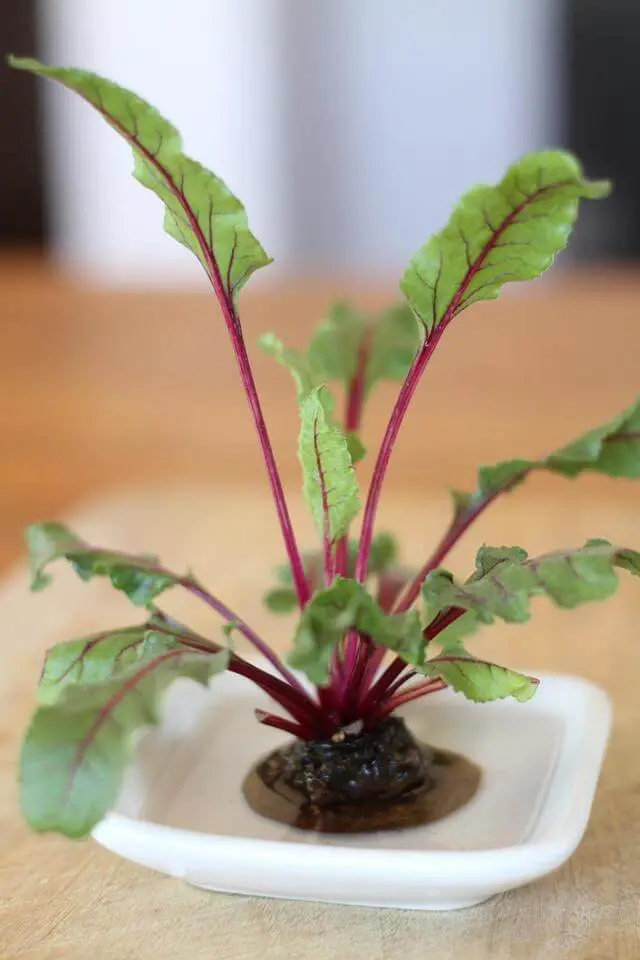
Beet greens, often overlooked by veggie enthusiasts, offer a wealth of nutritional benefits. Rich in Vitamin A and boasting higher iron content than spinach, they’re an excellent addition to soups, salads, pasta dishes, and other vegetable recipes. What sets them apart is their sweet flavor profile, which elevates the taste of any dish. In fact, beet greens are particularly well-suited for salad bowls, where their subtle sweetness shines.
To regrow this nutritious green in water, simply place the leafy top of a beet in a shallow dish filled with water, with the stem end facing downwards. Position it on your windowsill, where it can bask in plenty of sunlight. Remember to change the water every two days to prevent bacterial growth and ensure optimal conditions for regrowth. With proper care, you’ll enjoy a steady supply of fresh beet greens.
Bok Choy
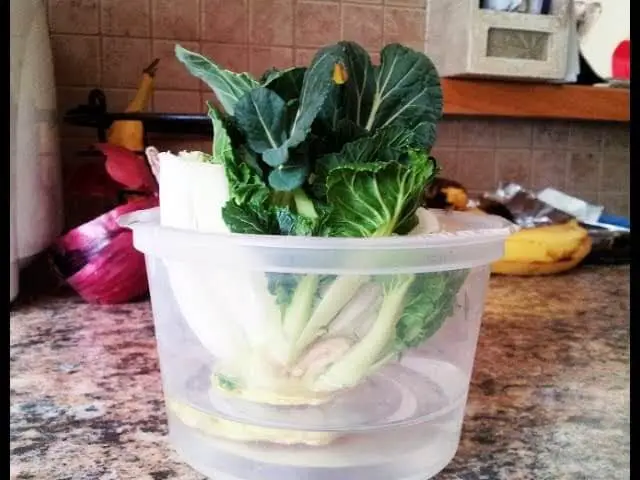
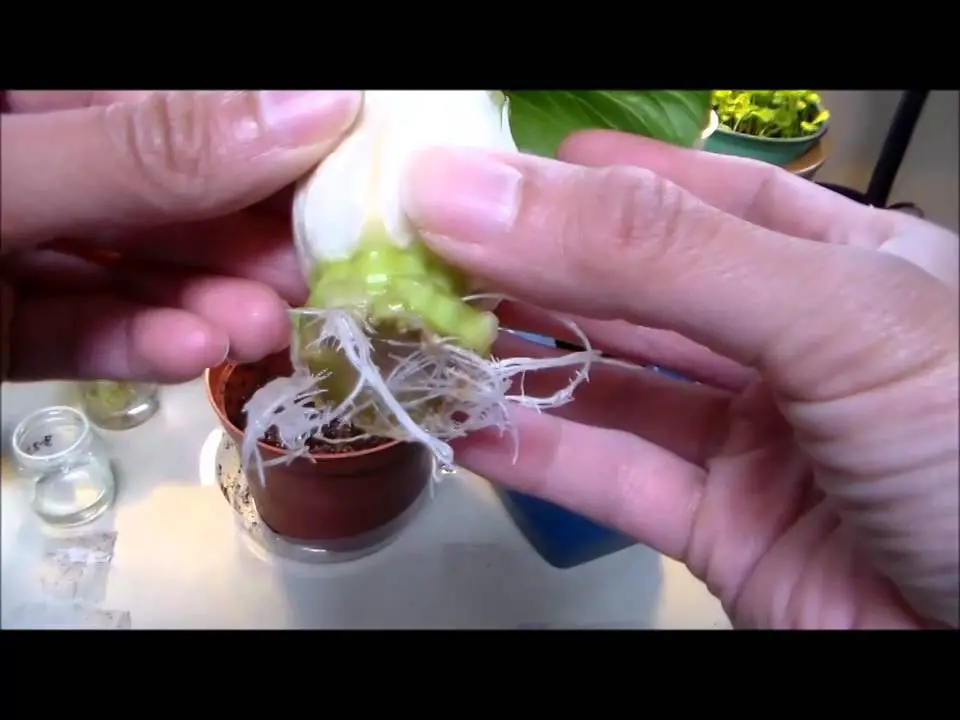
In many Asian cuisines, bok choy is a staple ingredient. Also known as Chinese cabbage, it’s incredibly versatile and can be enjoyed raw, steamed, or cooked into a variety of dishes. One of the key differences between bok choy and its close relative, pechay, is its compact size and thinner stems. While pechay may be a bit sweeter, bok choy boasts a crisper texture that makes it a delight to eat.
In fact, bok choy has an interesting history – it’s often found growing in river and stream banks, where it thrives in the waterlogged environment. If you’re interested in cultivating your own bok choy, the process is surprisingly straightforward. Simply cut off all the leaves from the base of the stem, leaving a small amount of white tissue intact. Place this ‘cut’ end facing upwards into a shallow dish filled with plenty of water.
Within hours, you’ll start to see new growth sprouting from the base of the plant – a process that can be repeated indefinitely for continued harvests. Alternatively, once the leaves have reached a suitable size, you can transfer the entire plant to a soil-filled pot and enjoy its bounty in a more controlled environment.
Carrot Tops
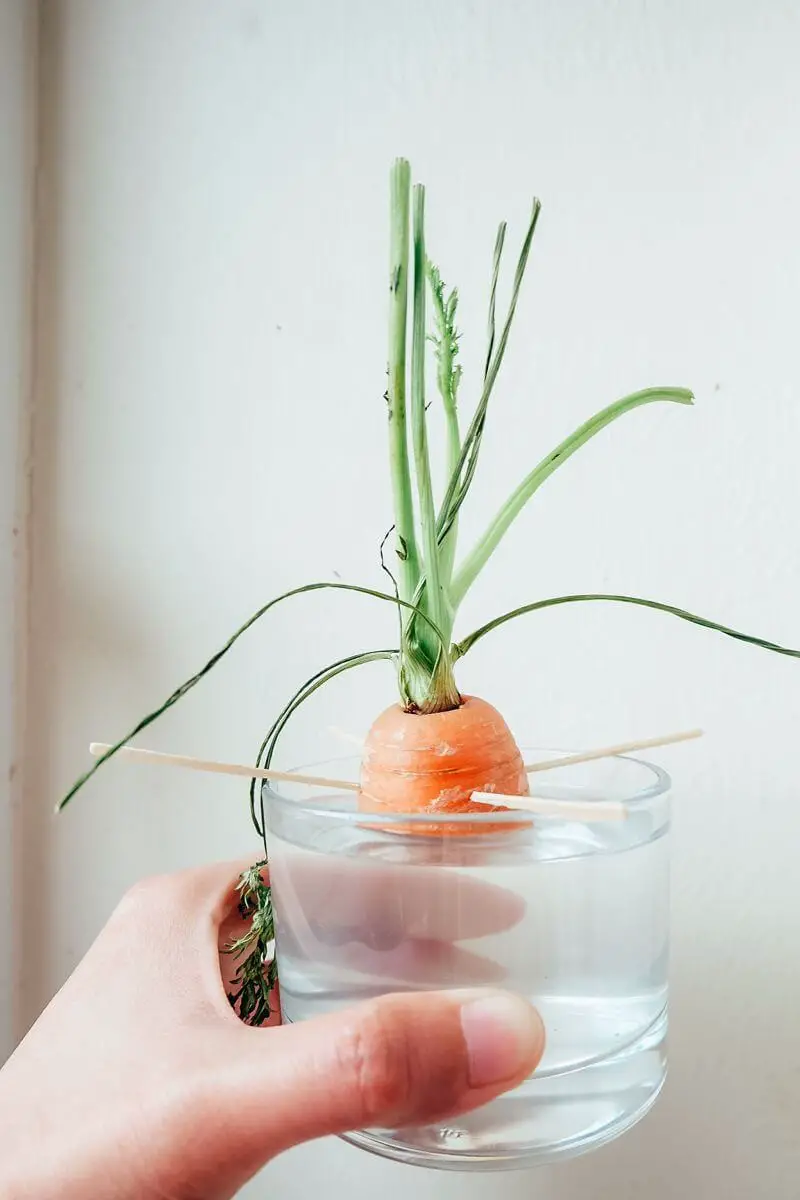
To successfully regrow carrots on water, start by preserving the carrot heads with sprouting leaves intact. To initiate the process, you’ll need a shallow container, cotton balls, and a minimum of 3cm of carrot top remaining. Begin by lining the dish with cotton balls and positioning the carrot top at its center. A crucial step is to maintain moisture on the cotton balls rather than filling the dish with water. This approach allows for optimal regrowth.
Additionally, ensure the dish receives sufficient sunlight, as adequate lighting plays a vital role in promoting healthy regrowth.
Lettuce
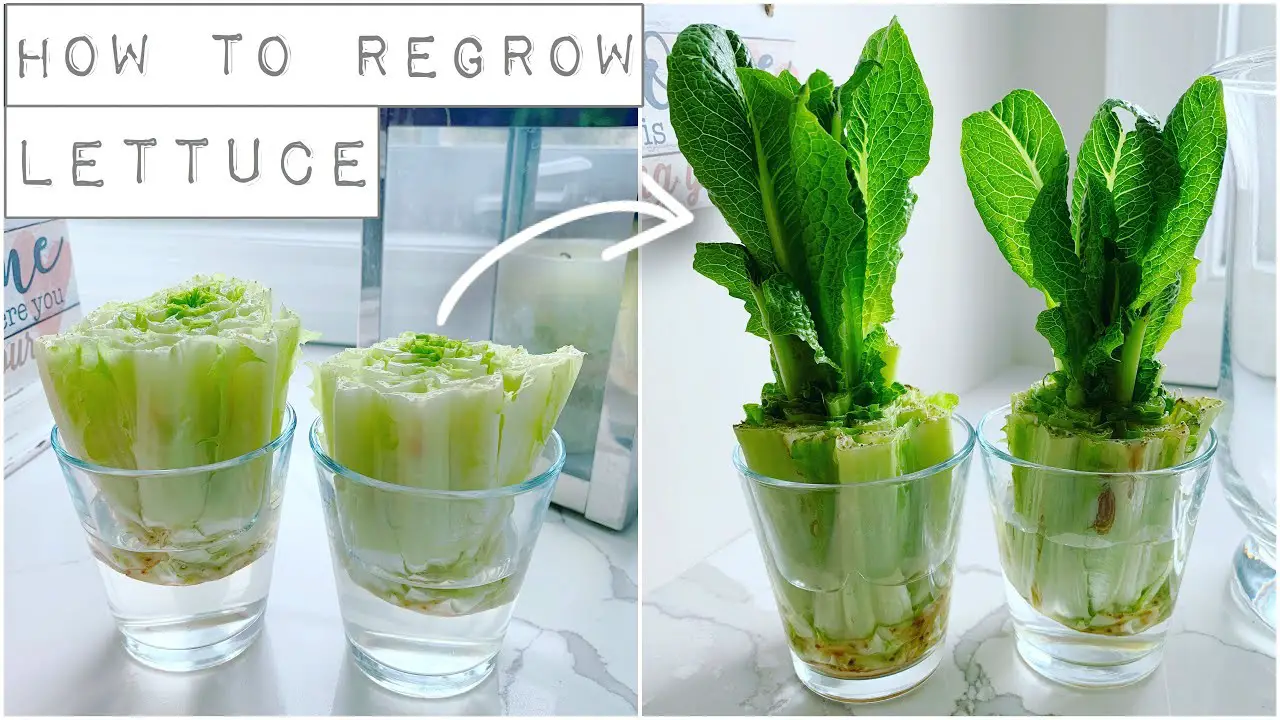
When it comes to regrowing lettuce in water, romaine lettuce is an excellent choice – its mild flavor makes it a great addition to sandwiches. To get started, cut one to two stems from the head and remove all the leaves. Next, place the stem in a dish filled with about 1.5 inches of water, ensuring it receives ample sunlight. For the next two weeks, change the water daily.
If you leave the regrown lettuce in the water beyond the 12-day mark, it will likely become bitter, turn blue-green instead of its usual rich green color, and lose its crunchy texture.
Leeks

Leeks, a staple in many savory dishes, exhibit a unique regrowing pattern similar to green onions. Their mild onion-like flavor makes them a popular choice for soups and stews. One of their most notable characteristics is their satisfying crunch and firm texture. The edible portion of the leek consists of the white base up to the pale green stem. To successfully regrow leeks in water, start by cutting ¾ to an inch from the root end and place it in a glass or jar.
Ensure the roots are fully submerged in ¾ water. Position the jar in a spot that receives ample sunlight and change the water once every seven days. Within a week, you should notice regrown leeks. This versatile ingredient can be used to add flavor to scrambled eggs, salads, and various Asian dishes. When attempting this method, it’s essential to use an opaque or tinted glass or jar to prevent bacteria buildup and algae growth.
Green Onions
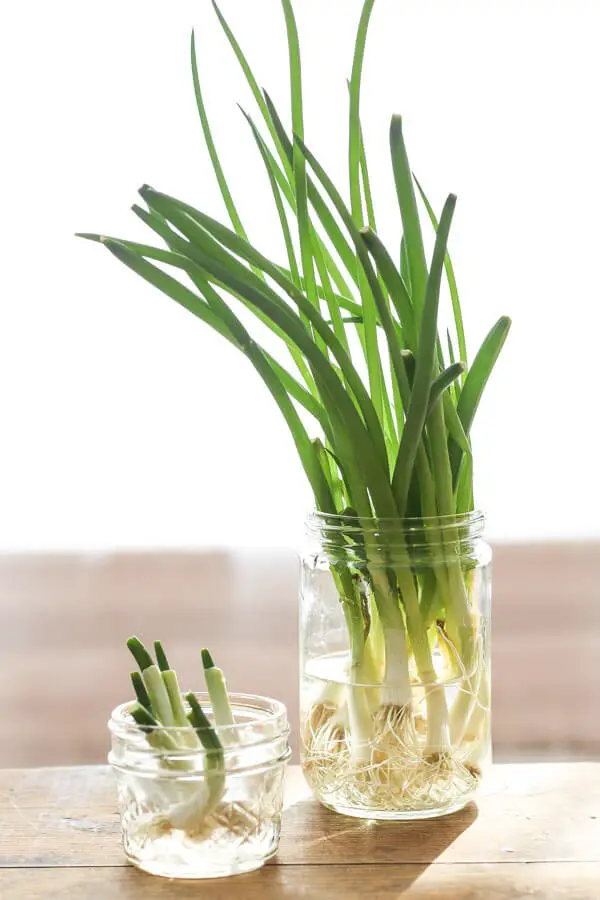
Green onions, also known as scallions, share a familial connection with shallots, leeks, chives, and garlic. As versatile ingredients, they’re commonly used in various dishes, from savory meals to soups, and even serve as a popular garnish. However, their utility doesn’t stop at the kitchen; with some simple care, you can regrow them on water, eliminating the need for future purchases.
To get started, preserve one or two root ends and place them in a glass or jar filled with about an inch of water. Position this setup on your windowsill, where the green onions will quickly sprout into fresh, edible greens. As they grow, simply swap out the water every week to maintain a steady supply of these tasty additions.
Edible plants that grow in ponds
While cultivating edible pond plants might seem like an unconventional approach to gardening, it offers numerous benefits. Not only do these plants provide a reliable and sustainable source of nutrient-rich produce, but they also eliminate the need for tedious tasks like weeding, mulching, and watering. Additionally, many edible plants grown in ponds are visually appealing as they mature. Some fascinating vegetables and salad greens that can be propagated in this way include…
Taro
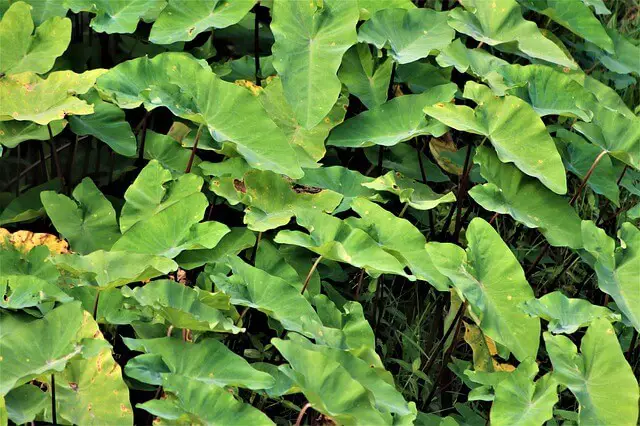
This Southeast Asian swamp-dwelling plant is easily cultivated via potting or planting at pond edges, as long as the leaves remain above water level. It thrives in aquatic environments and can be harvested for its young leaves within a short timeframe. The roots take around six to eight months to mature. With this versatile ingredient, you can whip up taro chips, soup, and more in no time.
However, it’s essential to exercise caution when handling raw taro leaves, as they contain calcium oxalate – a compound that can cause kidney stones if ingested.
Sweet Potato Vine
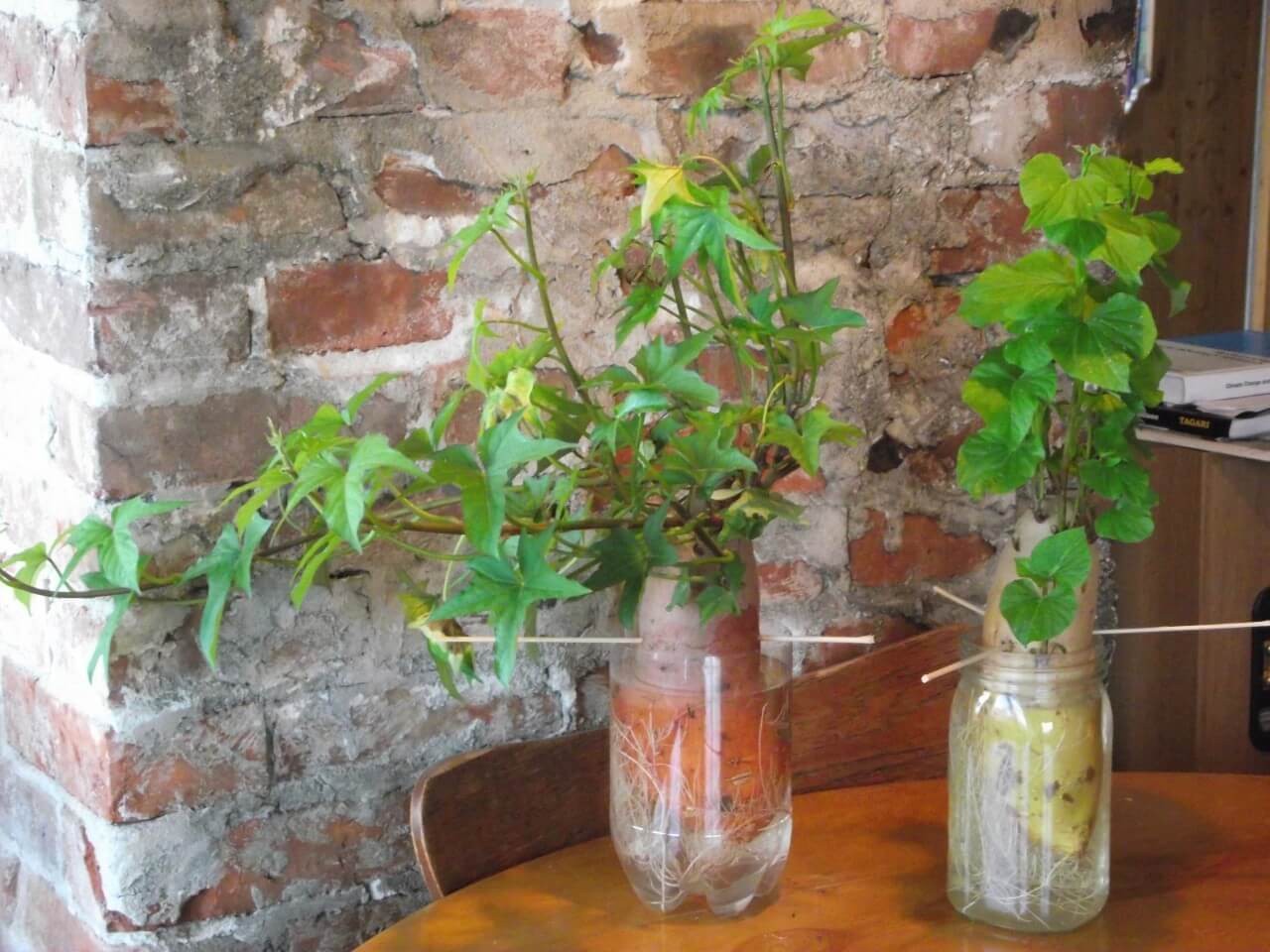
While Anacharis may not initially come to mind as an edible aquatic plant, it’s actually one of the fastest-growing species out there when cultivated in water. Its rapid spread can produce copious amounts of greens that are perfect for adding to soups and salads. However, its robust growth habit means it can quickly become invasive in ponds if not regularly trimmed back. A key consideration is that Anacharis is toxic to aquatic animals, including fish, leaving a bitter taste.
Fortunately, boiling or steaming the plant can help neutralize this bitterness, making it suitable for human consumption.
Water Spinach

This versatile swamp leaf, known by various names such as kangkong, swamp cabbage, or water morning glory, hails from Asia. Its tropical to subtropical climate tolerance allows it to thrive when grown in areas with pond edges, where seeds can be sown directly into the water. As it spreads aggressively, regular pruning is essential to prevent unwanted invasiveness. After four to six weeks, the leaves are ready for harvest.
Choose to regrow the plant or reap the entire harvest, and enjoy its addition to soups, stir-fries, or simply blanch it for a fresh salad.
Lotus
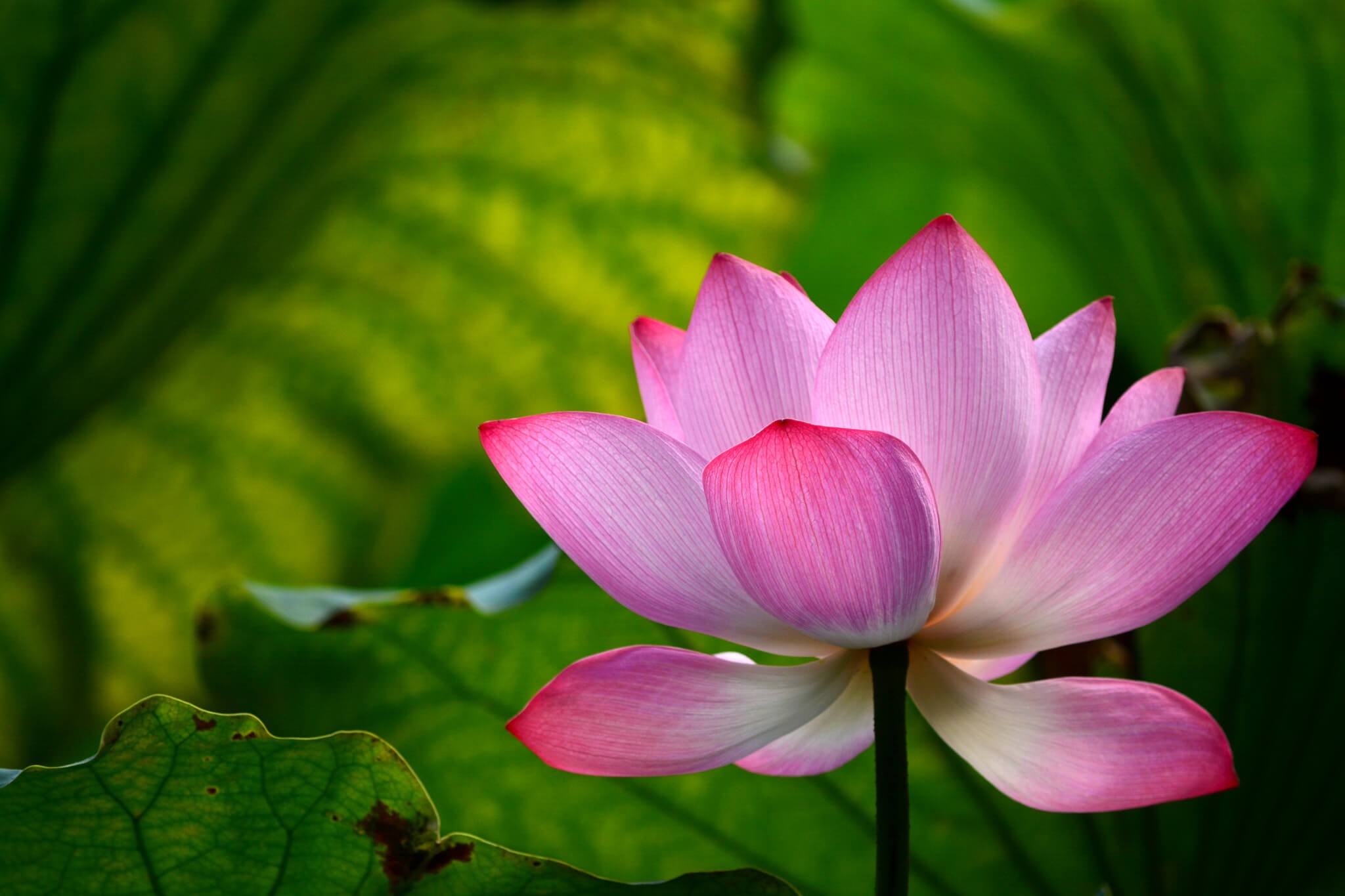
The lotus plant thrives in murky ponds or lakes, where it basks in direct sunlight. Its airy stems provide buoyancy, allowing it to float effortlessly on the water’s surface.
When cultivating indoors, choose a large glass container with sufficient depth for the roots to establish themselves. Simply submerge one stem with an visible bud in the water, and within one to two weeks, you’ll notice the emergence of roots. Tap water is ideal for this plant’s growth.
Tropical plants that grow in water
In the midst of a lush tropical garden, these remarkable plants thrive on high levels of moisture and humidity, as well as the gentle caress of sea breezes and heavy rainfall. Their hardiness and bold presence make them an excellent choice for adding a touch of exotic charm to your outdoor space. What’s more, they are surprisingly easy to cultivate, adaptable to various soil types, and require minimal upkeep.
If you’re interested in exploring tropical plants that can be grown hydroponically, here are some top picks to consider.
Giant Horsetail
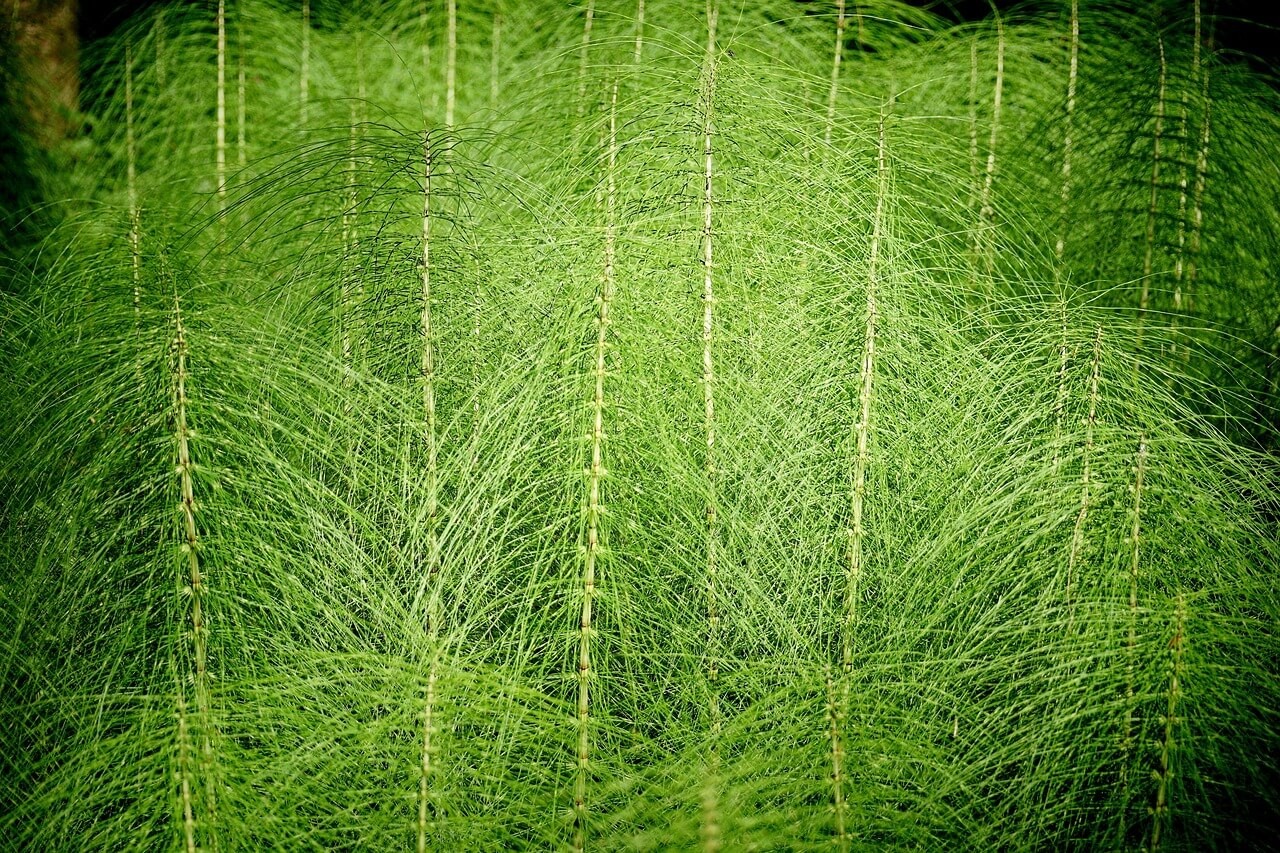
In the lush regions of south-central America, you’ll find this unique plant thriving in damp soils. Its jointed stems may initially be mistaken for bamboo, but its tropical flair adds a touch of exotic charm to a water garden. A striking feature of this plant is its ability to survive without flowers or leaves – it’s often used as a pond edger due to its versatility and hardiness.
When grown in water, simply cut 3-4 inches from the stem and place it where it can receive ample but indirect sunlight. This fast-growing species spreads aggressively by runner, requiring careful attention to prevent overgrowth.
Egyptian Paper Reed
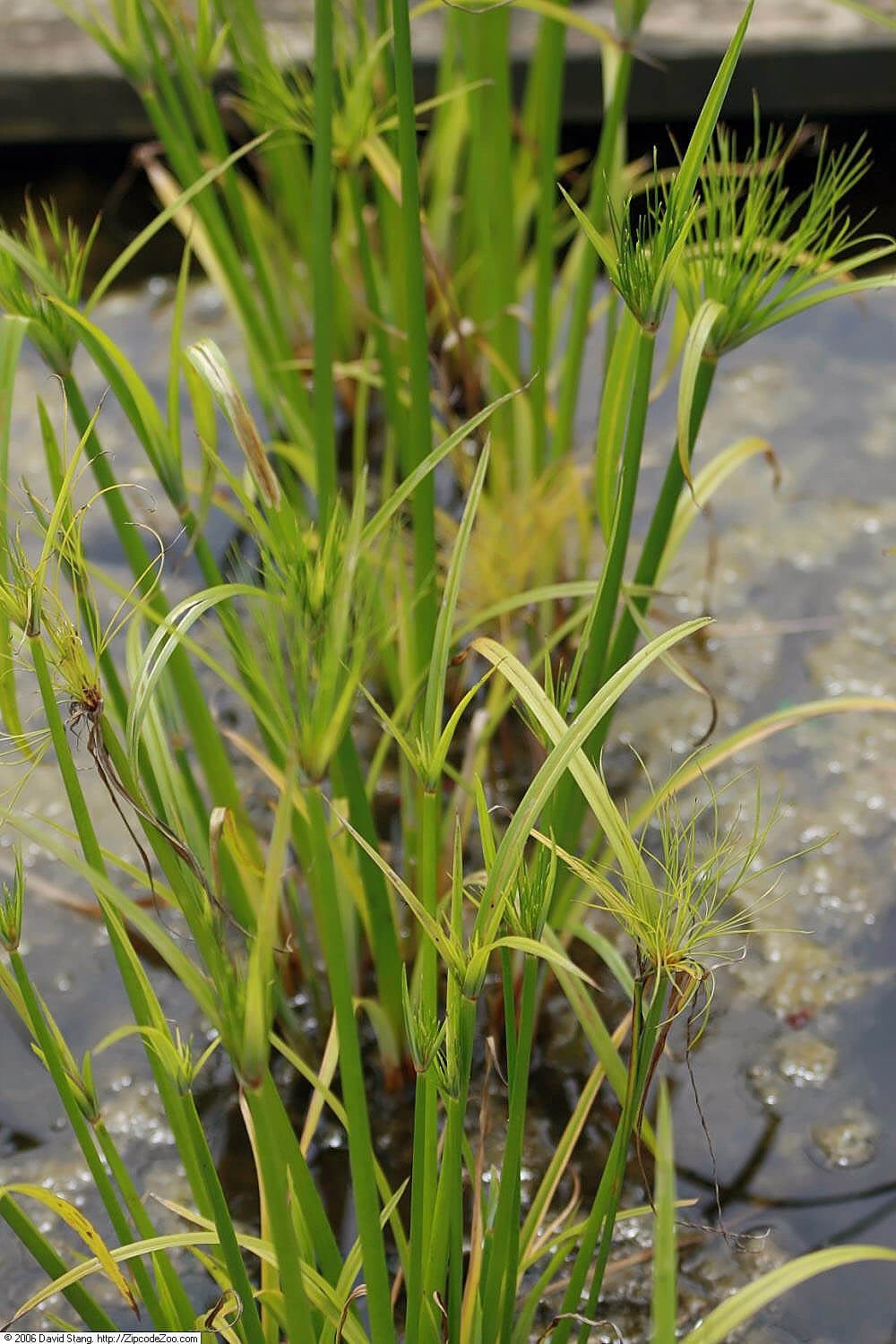
For centuries, the Papyrus plant has been a staple of ancient Egyptian culture, its significance extending back to the earliest civilizations. Found naturally along pond, river, and lake banks, this versatile plant played a crucial role in everyday life, used for crafting reed baskets, canoes, strings, ropes, and even shoes.
As a houseplant, Papyrus brings a touch of tropical elegance to pond gardens, water features, and containers alike.
When grown in containers, it thrives in shallow water vases, adding an air of serenity to any room.
Umbrella Grass
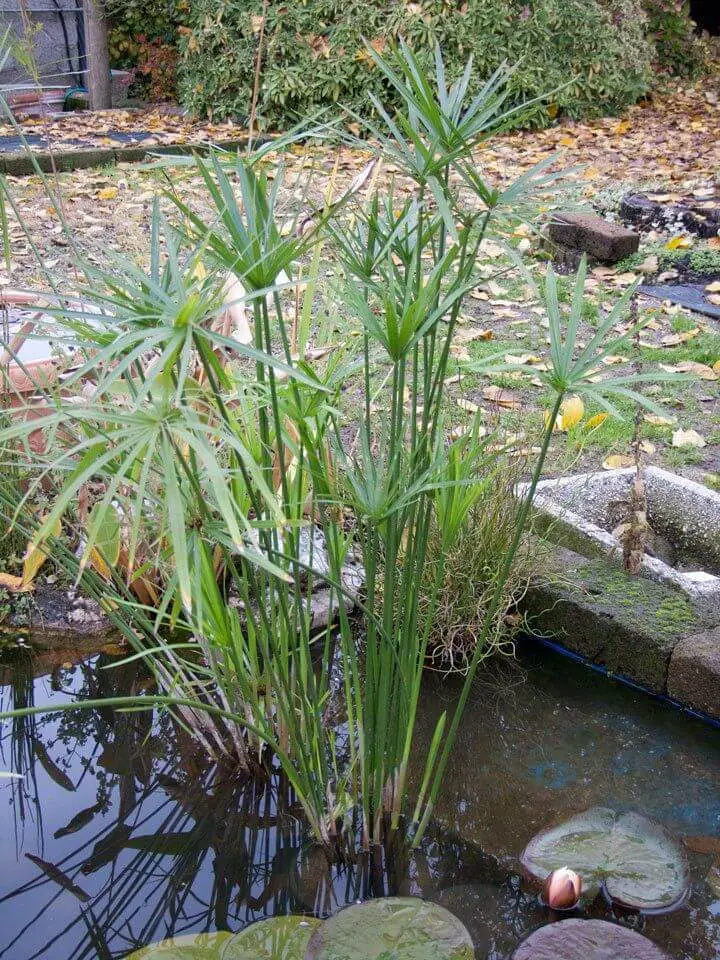
The tropical plant known as umbrella papyrus, sedge, or palm is an incredibly resilient and adaptable species. Its natural habitat is damp environments or those surrounding water sources, where it can grow to resemble water reeds. This hardy plant stands tall, requires minimal maintenance, boasts a striking appearance, and provides a dramatic pop of color in the garden. Its versatility allows it to thrive across a broad range of light and temperature conditions.
However, it is susceptible to disease when under-watered. In its natural state, umbrella papyrus is considered invasive, but as a houseplant, it matures into an attractive and charming addition to any space.
Conclusion
At the core of our exploration into growing plants in water, we discovered that some species are naturally adept at thriving in this environment. From indoor plants to herbs and even vegetables that can be regrown using scraps, there’s a wealth of options available. Moreover, certain edible and tropical aquatic plants lend themselves perfectly to creating a pond garden. What’s more, our findings suggest that you don’t need an elaborate or expensive hydroponics setup to cultivate plants in water.
In fact, we’ve uncovered a simpler approach to planting that eliminates the need for soil excavation, constant watering, mulching, and weeding. This low-maintenance method is not only accessible but also sustainable – even children can participate by regrowing herbs and vegetables using scraps. Ultimately, our research has confirmed that growing plants in water is indeed possible and offers a convenient alternative to traditional planting methods.
Related Posts
As homeowners and urban farmers, it’s essential to stay abreast of innovative methods for optimizing crop growth. One such approach is drip irrigation, which offers numerous advantages that can significantly enhance the success of your hydroponic endeavors. With this technique, water and nutrients are delivered directly to the roots of plants, allowing for precise control over moisture levels.
This not only conserves precious resources but also reduces waste and promotes healthy plant development. In addition to its practical benefits, drip irrigation has been linked to increased crop yields, improved soil structure, and a decrease in the overall environmental impact of farming practices.






